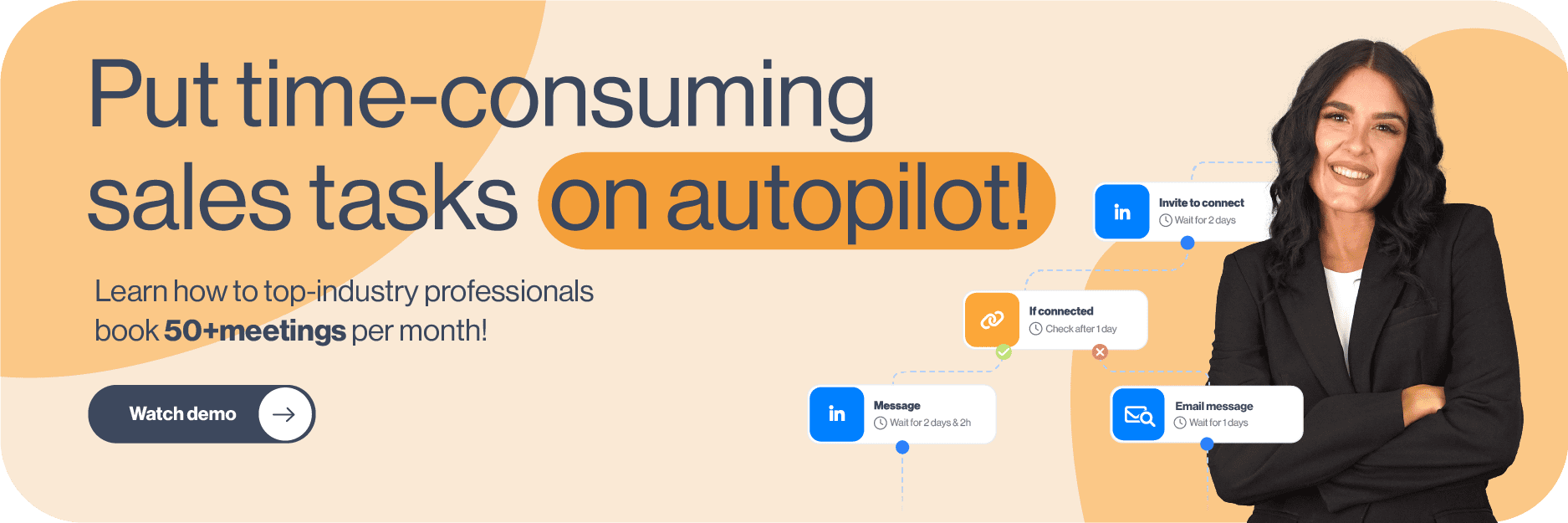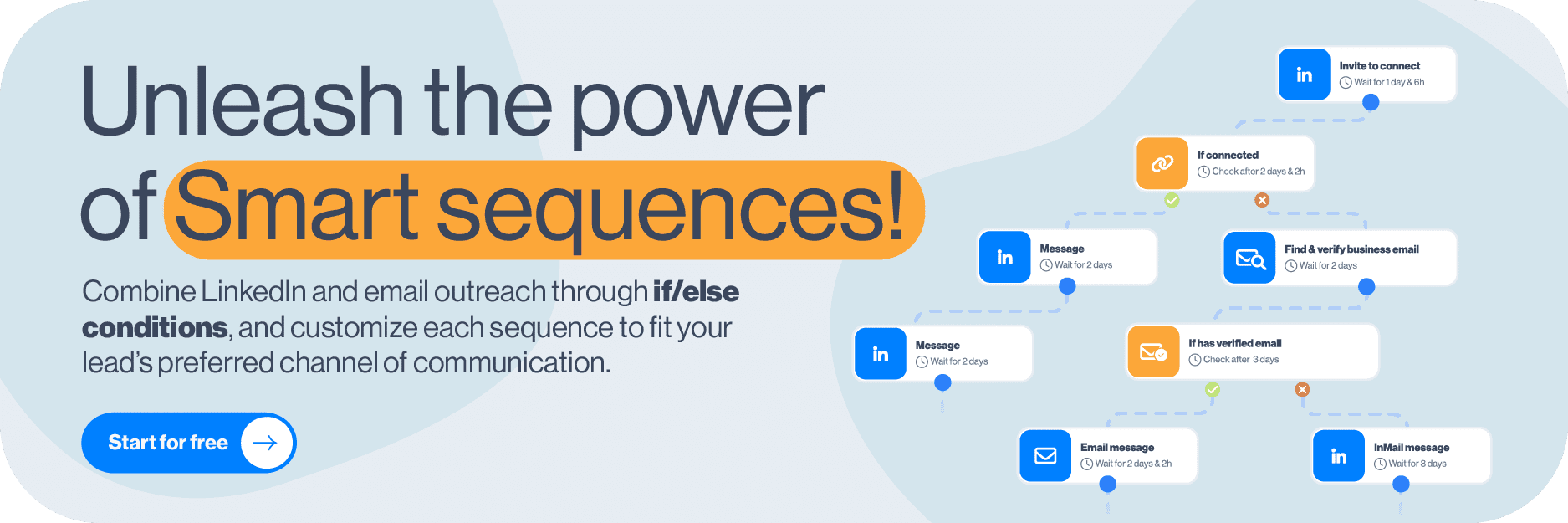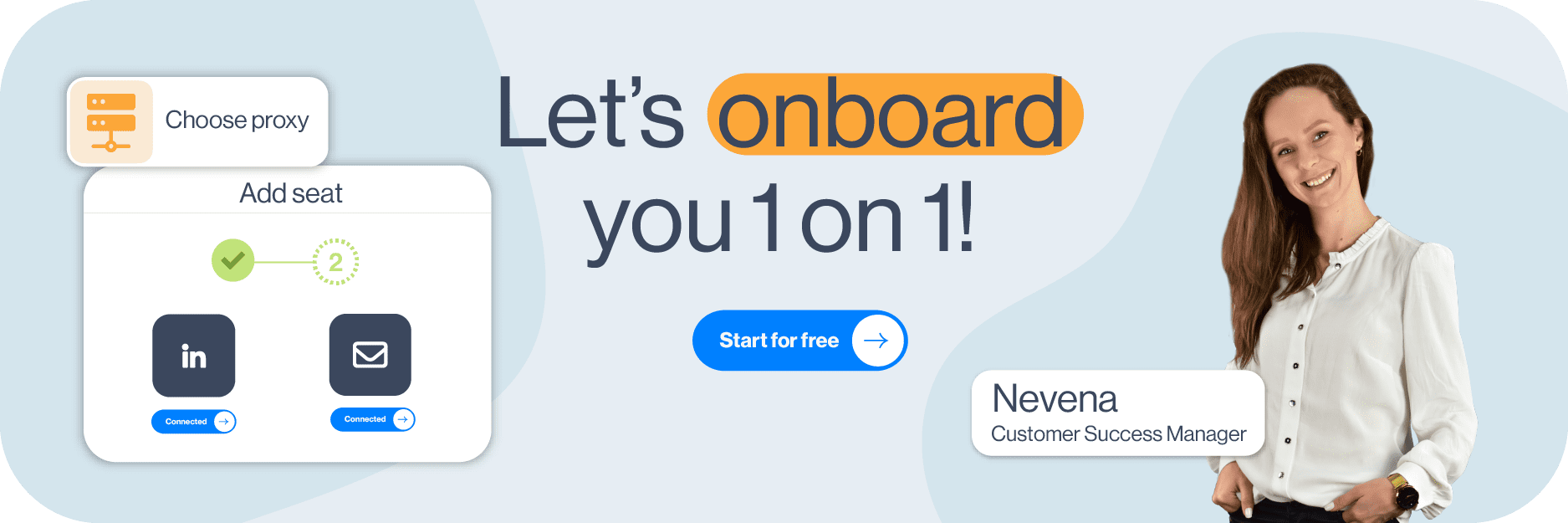Have you spent hours crafting those perfect emails for them to finally land…but in SPAM? We know how frustrating that can be! Email service providers nowadays are stricter than ever about what they let through, and if your email accounts aren't warmed up properly, chances are, your emails will never see the light of day. Worse yet, when your deliverability is affected, so is your sender reputation and, ultimately, your entire success in cold outreach. But that's what you've got email warm-up tools for!
Think of them as personal trainers, but for your email. They exist to gradually build up your sender reputation, helping you avoid those dreaded spam filters so your emails land directly where they belong—in your recipients' primary inboxes.
Many companies have decided to develop their own email warm-up tools, resulting in your having quite a pick. The question is, how do you choose from the bunch?
There are several criteria that you should consider when deciding on the perfect email warm-up solution. We’ll go through each one in detail, but first, let’s explain:
- What email warm-up is,
- Why you should warm up your emails,
- The ins and outs of email warm-up tools.
As a cherry on top, we’ll walk you through 12 email warm-up tools we personally tested to help you find the perfect fit and boost your deliverability today!
| Email warm-up tool 🔥 | Best for 🥇 | Link 🔗 |
| InboxFlare | AI-powered, infinite email warm-up | Read more… |
| Lemwarm | Detailed deliverability insights | Read more… |
| Mailivery | Domain reputation tracking | Read more… |
| Warmbox | Simple self-setup | Read more… |
| Mailwarm | Flexibility in warm-up intensity | Read more… |
| Folderly | Keeping emails out of the Promotions folder | Read more… |
| Instantly | Automated cold emailing with the built-in warm-up | Read more… |
| Warm Up Your Email | Manual email warm-up | Read more… |
| MailReach | Real-time reputation tracking | Read more… |
| Smartlead | Email provider matching | Read more… |
| Mailflow | Blacklist tracking | Read more… |
| Allegrow | Integration with CRM and outreach platforms | Read more… |
What is email warm-up?
Email warm-up is the process of gradually increasing the number of emails sent from a new or low-activity account. This helps you build a positive reputation with email service providers (ESPs).
During the warm-up phase, you start by sending a small number of emails, either manually or automatically, through an email warm-up tool. These tools usually have a database of email addresses, often from other tool users. What they do is automatically exchange emails between these addresses and reply to them to simulate real conversations. Moreover, they typically organize warm-up emails into dedicated folders in your inbox to keep them from cluttering it.
This process helps make your email activity look natural to ESPs, showing them that your emails are valuable and wanted. As your engagement grows, you can safely scale your email outreach without risking your sender's reputation.
Benefits of email warm-up
In 2023, approximately 45.6% of all emails worldwide were marked as spam.
Want to make sure that doesn’t happen to yours? Start warming up your email accounts!
That said, here’s what you stand to gain from doing so!
1. Better deliverability
Warming up your account improves deliverability by building trust with email providers. When you start small and slowly increase your sending volume, providers recognize you as a reliable sender. This keeps your emails out of spam folders and makes sure they reach primary inboxes.
2. Lower bounce rate
When you warm up your account manually, you’ll probably take time to make sure you’re only sending emails to valid addresses likely to receive them. Email warm-up tools, however, already have a database of active and valid email addresses, helping you avoid sending to inactive ones. As a result, your bounce rate becomes lower. With fewer bounces over time, your account maintains a stronger standing reputation, ultimately supporting your long-term outreach success.
3. Improved sender reputation
Sender's reputation is like the credit score of email outreach. It’s the measure ESPs use to decide whether to trust your emails. Email warm-up builds this reputation steadily through positive interactions like opens and replies. A stronger reputation means your emails are more likely to reach their destination, helping you maximize your results.
What are email warm-up tools?
Email warm-up tools ''train'' your email account to handle large-scale outreach campaigns without triggering spam alarms. They automate the process of slowly ramping up your email-sending volume, which helps you establish a solid sender reputation with ESPs. By keeping your email activity consistent and boosting engagement, these tools improve deliverability, lower bounce rates, and set the stage for successful outreach.
How do email warm-up tools work?
Most email warm-up tools operate by sending emails from your account to a network of engaged contacts—often other users within the tool’s ecosystem. They also handle recipient interaction by opening emails, replying, and sometimes even marking them as ‘’Not spam.’’ This simulated engagement is what ESPs look for in trusted senders, making email warm-up tools a fast and reliable way to build credibility.
Common features of email warm-up tools include:
- Automated sending and replying: The tool sends a controlled number of emails each day, gradually scaling up. They also engage with these emails from the recipients’ side, mimicking real interactions that ESPs expect from reputable senders.
- Spam recovery: If any of your emails end up in spam, many tools can help pull them out to reinforce your sender's reputation.
- Customizable settings: Most tools offer flexibility, allowing you to adjust daily limits, warm-up duration, and engagement targets to align with your outreach goals.
Simply put, email warm-up tools make it easy to scale up safely. They handle the warm-up process automatically to allow you to run email campaigns that actually find their way to your audience.
Pros and cons of email warm-up tools
As you can see, email warm-up tools are pretty handy. But just like anything else, they are not perfect.
Let’s break down their pros and cons to get a full sense of what they offer and where they fall short.
Pros of email warm-up tools
1. Automated process
Email warm-up tools take the manual work out of the equation. They automate the sending, replying, and engagement needed to build up your reputation, which saves you time and ensures a consistent process.
2. Improved deliverability
By gradually increasing your sending volume and facilitating positive engagement between you and other tool users, email warm-up tools help you avoid spam filters and boost deliverability. As a result, your emails are more likely to land in your leads’ inboxes, which means more of them will actually see them.
3. Reputation building
Warm-up tools make it easier to build and maintain a good sender’s reputation. Many of these tools simulate human interactions, which ESPs recognize as positive signals. This reputation-building function is particularly important for new accounts or accounts that have experienced deliverability issues in the past.
4. Customizable settings
Most email warm-up tools offer settings you can adjust according to your requirements. This may include making adjustments to daily sending limits or setting the warm-up duration.
Cons of email warm-up tools
1. Subscription costs
Email warm-up tools can come at a hefty price. This cost may feel like a barrier to some, specifically when other expenses are also in play.
2. Potential for over-reliance
While great for warming up new accounts or improving deliverability, email warm-up tools don’t have the same quality. Moreover, relying solely on one without considering email content quality, frequency, or list hygiene could lead to issues down the road.
3. Lack of instant results
Building a reputation takes time, and even with automated assistance, it may take weeks for a new account to reach full-scale sending. So, if you’re looking for a quick fix, a warm-up tool might not be the immediate solution you need.
4. Varying success across providers
Some email service providers are more receptive to warm-up techniques than others. Depending on the ESPs you’re targeting, you may see different levels of success.
Best email warm-up tools to boost deliverability and stay away from spam
So, you know what email warm-up is all about. But now it's time to find the right tool for the job.
Lucky for you, we’ve curated a list of 12 email warm-up tools, all so we can help you improve deliverability, reduce bounce rates, and stay clear of those pesky spam filters.
1. InboxFlare - Best for AI-powered, infinite email warm-up
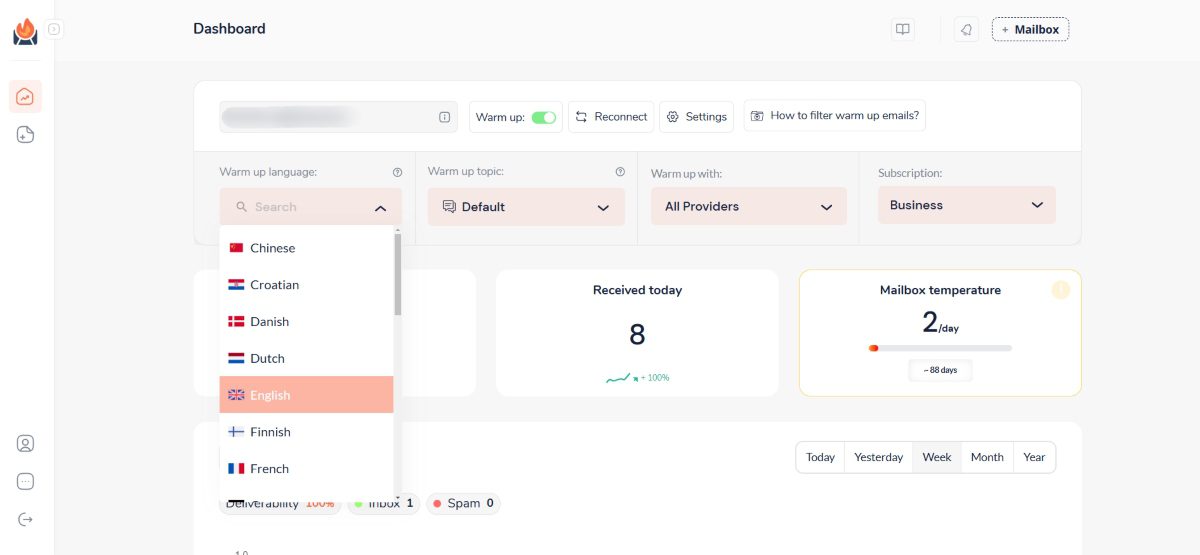
InboxFlare is an email warm-up tool that is only integrated with partnership tools like our Skylead. As a result, you get everything you need for outreach without paying extra!
Skylead has long been your ultimate LinkedIn automation and cold email software.
In fact, we were the 1st tool on the market to introduce Smart sequences—ground-breaking algorithms that let you take advantage of multichannel outreach to reach your leads wherever they are.
Smart sequences combine LinkedIn and email actions to form coherent outreach sequences that Skylead will follow to get in touch with your leads. This way, it makes sure you find the fastest path to your leads!
Now, thanks to our partnership with InboxFlare, we’ve taken Skylead to a whole new level!
We've become a real one-stop-shop solution that lets you:
- Harness the full power of LinkedIn automation and unlimited email outreach,
- Discover & double-verify leads' emails to reduce bounce rates and protect your domain,
- Hyper-personalize GIFs and images to increase your response rate to over 76%,
...but also warm up infinite email accounts to keep your emails away from spam—forever!
That's right! You get all of this at one cost!
All Skylead users can create InboxFlare accounts to start warming up their emails in 30+ languages.
Once you’ve created the account, just add your email and let InboxFlare handle the rest. It's compatible with all major email providers, including Gmail, Outlook, and Zoho, and also supports custom SMTP.
InboxFlare’s AI crafts a warm-up strategy customized to your domain’s unique needs, improving your sender reputation on autopilot.
But it doesn’t send just any generic warm-up emails—you can choose specific topics, and it will generate and send customized messages on your behalf, making the warm-up process even more authentic.
In addition to building reputation, InboxFlare continuously monitors your email health by checking blacklists, domain configurations, and inbox settings.
Plus, you can run deliverability tests to assess whether your mailbox server is blacklisted, see where your emails land in different inbox providers, and adjust warm-up accordingly.
Pricing
InboxFlare comes at no extra cost! With a Skylead subscription, you can warm up an infinite number of emails and unlock every other feature Skylead offers—all for just $100 a month.
That means full power to boost your deliverability, automate email and LinkedIn outreach, and manage leads in one package.
2. Lemwarm by Lemlist - Best for detailed deliverability insights
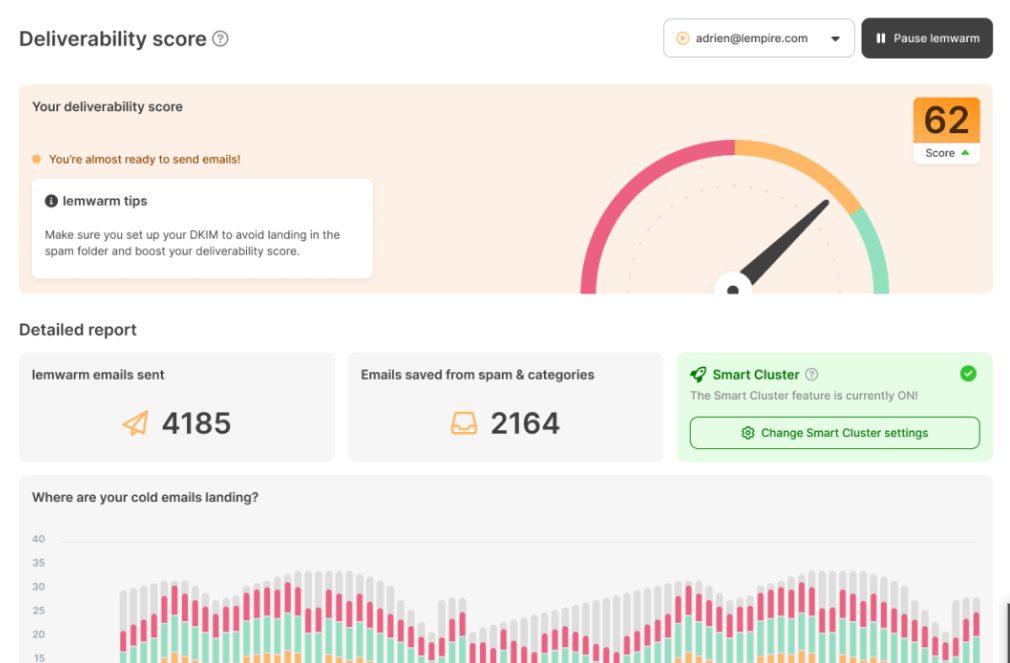
Lemwarm is an email warm-up tool developed by Lemlist. But since it’s an add-on rather than integrated into the platform, it’s available for standalone usage.
It works by sending automated emails to a network of over 20,000 users, gradually boosting your deliverability.
The tool also offers alerts on your deliverability score, spam risk detection based on your email content, and daily insights with expert tips to optimize performance.
Moreover, detailed deliverability reports help you stay on track and keep your emails landing in the right place.
However, the pricing structure is based on the number of emails you warm up, meaning costs can quickly add up.
Not to mention, while our testing ran smoothly, one reviewer, Vinayak G., noted:
‘’All our warm-up emails were going to the spam and categories section, which was really frustrating.’’
So, while Lemwarm proved effective to us, specific cases suggest it’s not ideal.
Pricing
Lemwarm is free for Lemlist users.
If you’d like to use it alone, you can, but expect to pay the following amount:
| Essential Plan | $29/mo per email account |
| Smart Plan | $49/mo per email account |
3. Mailivery - Best for domain reputation tracking
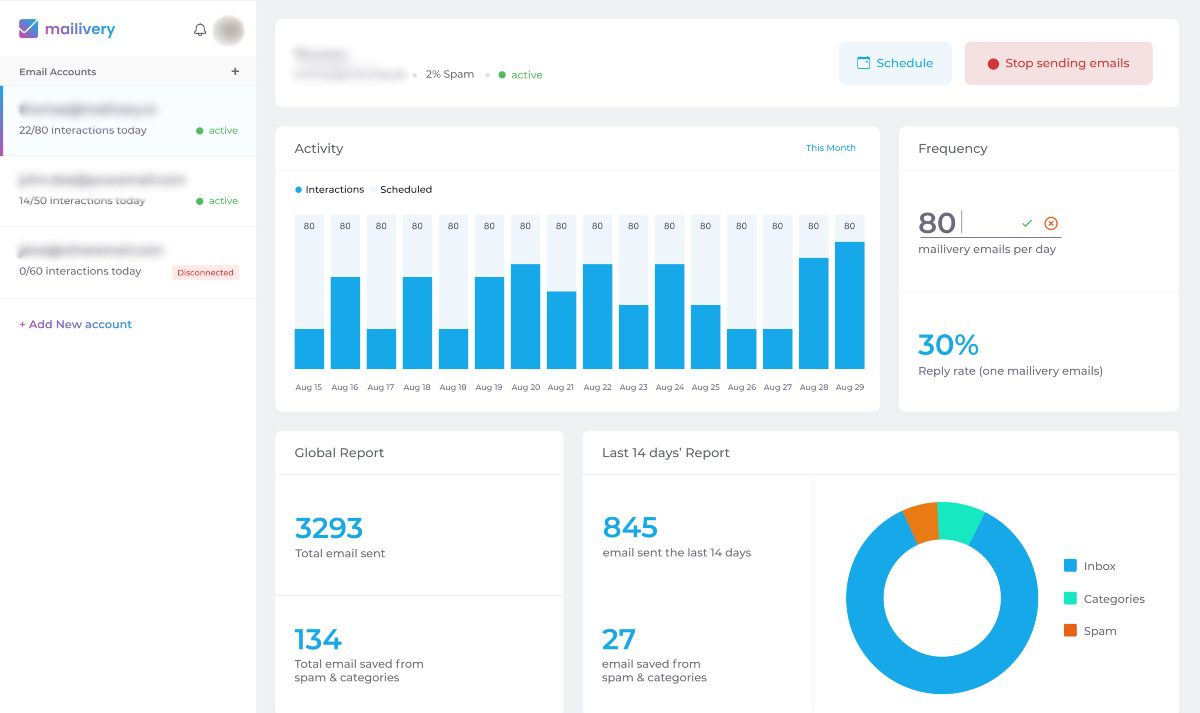
Mailivery is an AI-driven email warm-up tool designed to boost deliverability by interacting with real emails behind the scenes.
It removes emails from spam, generates positive replies, like Lemwarm, and works with a network of over 20,000 real users to simulate authentic engagement.
Its intuitive dashboard provides real-time insights into spam placement and detailed analytics to track your domain reputation. What’s more, you can check if you're blacklisted and get personalized recommendations for improvement.
While Mailivery offers full customization of warm-up volume and timing, which we liked, some users report there’s a bit of a learning curve to it.
Additionally, the tool limits the number of warm-up emails sent daily despite allowing you to warm up unlimited mailboxes.
Pricing
| Free *1 email account / up to 10 interactions a day | |
| Starters | $29/mo *Unlimited email accounts / up to 100 interactions a day |
| Professional | $79/mo *Unlimited email accounts / up to 600 interactions a day |
| Business | $199/mo *Unlimited email accounts / up to 2,000 interactions a day |
4. Warmbox - Best for simple self-setup
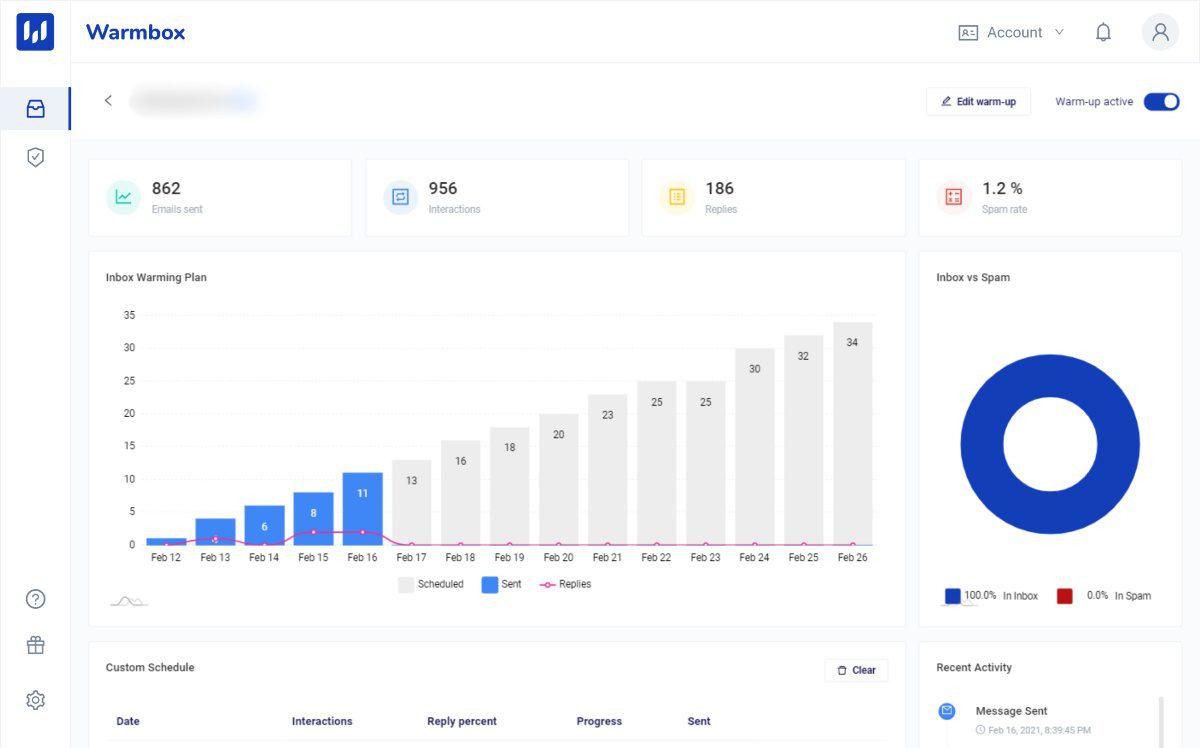
Warmbox is one of the easiest email warm-up tools to use and is great for those who want a simple, self-setup experience.
The software automates the whole email-warm-up process using inboxes from real users and doesn’t interfere with your email routine.
Beyond improving deliverability, Warmbox also calculates your Reputation Score, compares it against a community benchmark, and suggests ways to improve. It even sends you alerts if your score drops below a certain percentage, so you can pause campaigns before things get worse.
However, it can get pricey, especially since you’re charged per inbox, and there’s no free trial available.
Pricing
| Basic | $19/mo per inbox *Up to 75 warm-up messages a day |
| Pro | $59/mo per inbox *Up to 250 warm-up messages a day |
| Max | $99/mo per inbox *Up to 1,000 warm-up messages a day |
5. Mailwarm - Best for flexibility in warm-up intensity
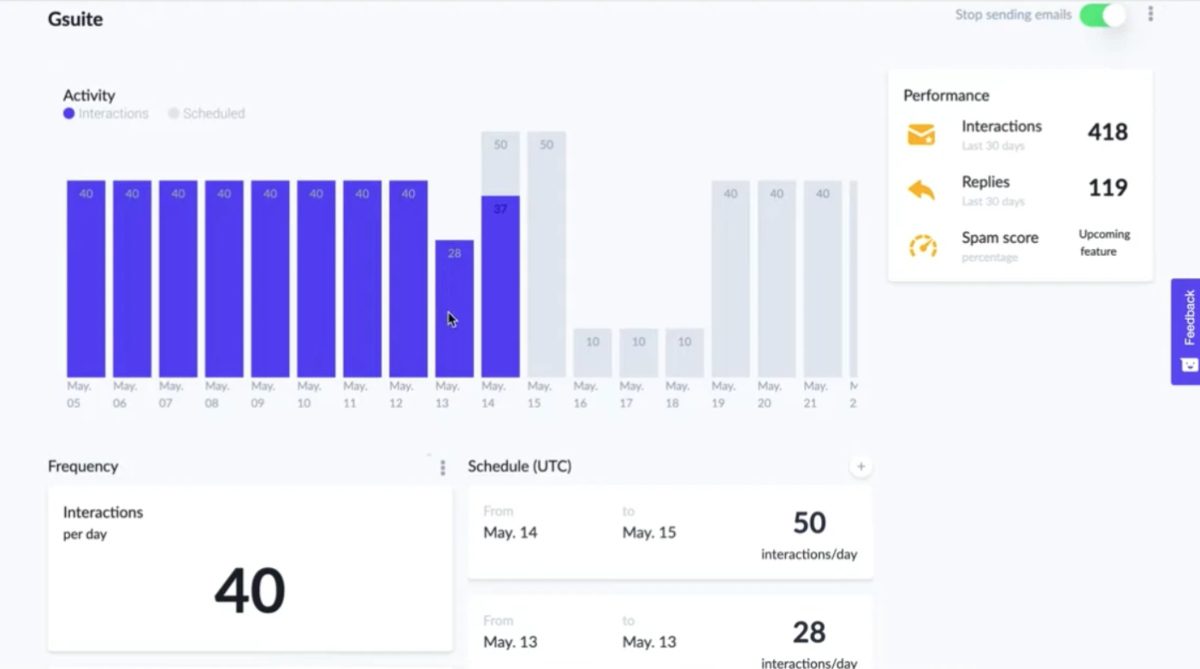
Mailwarm helps raise your sender reputation by interacting with your emails daily.
It automatically sends dozens of emails to over 1,000 Mailwarm accounts, where they get opened, marked as important, replied to, and pulled out of spam.
You can track everything through a dashboard that gives you insights into your email activity. You also have the flexibility to adjust Mailwarm’s intensity or pause the warm-up process if and when necessary.
Nevertheless, the major limitation we found is that even with the highest subscription plan, you’re capped at warming up a maximum of 10 inboxes. And considering its hefty price, you may be better off choosing a different email warm-up software.
Pricing
| Starter | $79/mo per user with 1 email account |
| Growth | $189/mo per user with up to 3 email accounts |
| Scale | $549/mo per user with up to 10 email accounts |
6. Folderly by Belkins - Best for keeping emails out of the Promotions folder
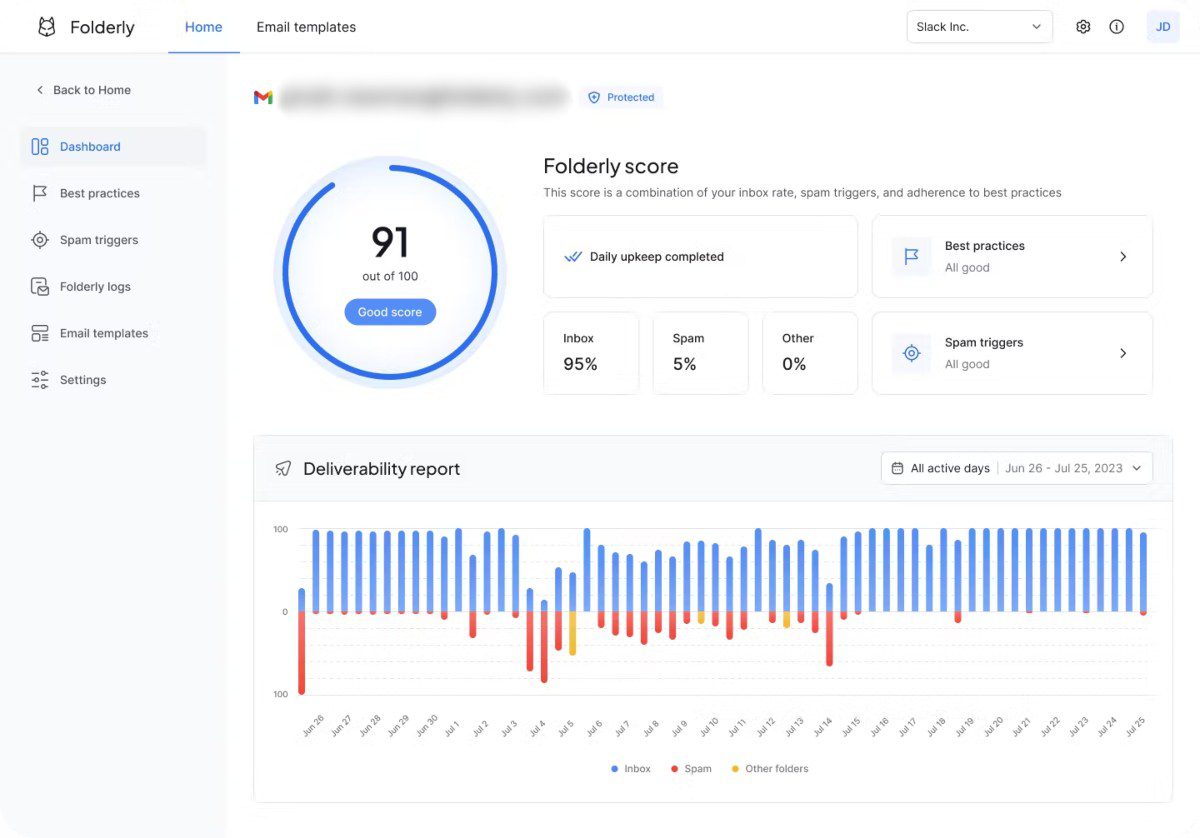
Folderly is developed by Belkins, a company known for its B2B lead generation and outreach services.
Its main promise is to keep your emails out of spam and promotions folders with an impressive 99% inbox placement rate. It offers insights on why emails end up in spam, helps you optimize templates, checks your DNS records, and integrates with the most popular ESPs like Gmail and Outlook.
We haven't experienced major issues while testing Folderly, but multiple users have complained about it doing more harm than good.
And after reading this review left by Oguzhan U., in particular, we are seriously starting to question the tool’s reliability:
‘’Folderly sent 42,000 undelivered emails in 2 days (Saturday and Sunday) using 8 email addresses in our domain. Our team didn't realize the issue until Monday. Our email domain reputation is completely destroyed. That is completely the opposite of why we wanted to use Folderly.’’
Pricing
Folderly doesn’t have pricing plans, per se.
Instead, their rates depend on the number of mailboxes you’re warming up and are structured like this:
| 1-9 mailboxes | $120/mo per mailbox |
| 10-24 mailboxes | $90/mo per mailbox |
| 25-99 mailboxes | $70/mo per mailbox |
| 100+ mailboxes | Custom / Contact sales |
7. Instantly - Best for automated cold emailing with the built-in warm-up
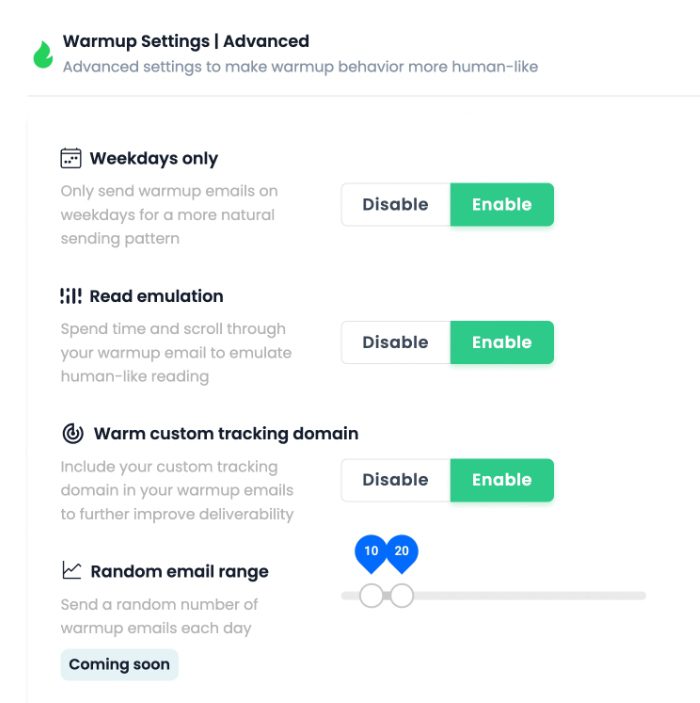
Instantly isn't a standard email warm-up tool but one of the best cold email software with built-in warm-up functionality that can be activated with a click.
The software allows you to monitor your deliverability score, showing exactly how many emails land in the inbox or spam. You can also emulate human-like reading by enabling the read emulation feature, which scrolls through emails to simulate authentic interaction.
The tool sends a random number of warm-up emails daily, and you can choose specific open and response rates.
Moreover, with a pool of over 550,000 real email accounts for warm-up, Instantly.ai's coverage is vast.
The price is reasonable, considering that, starting at $37, you can warm up unlimited emails.
Nonetheless, some users have reported that its warm-up can blacklist your domain with certain ESPs, so exercise caution if you decide to use it.
Pricing
Instantly doesn’t have a dedicated email warm-up plan.
Nonetheless, email warm-up is included in their following Sending & Warmup plans, along with email outreach.
| Growth | $37/mo per seat *Unlimited warm-up / 5,000-email monthly send limit |
| Hypergrowth | $97/mo per seat *Unlimited warm-up / 100,000-email monthly send limit |
| Light Speed | $358/mo per seat *Unlimited warm-up / 500,000-email monthly send limit |
8. Warm Up Your Email by Mailshake - Best for manual email warm-up
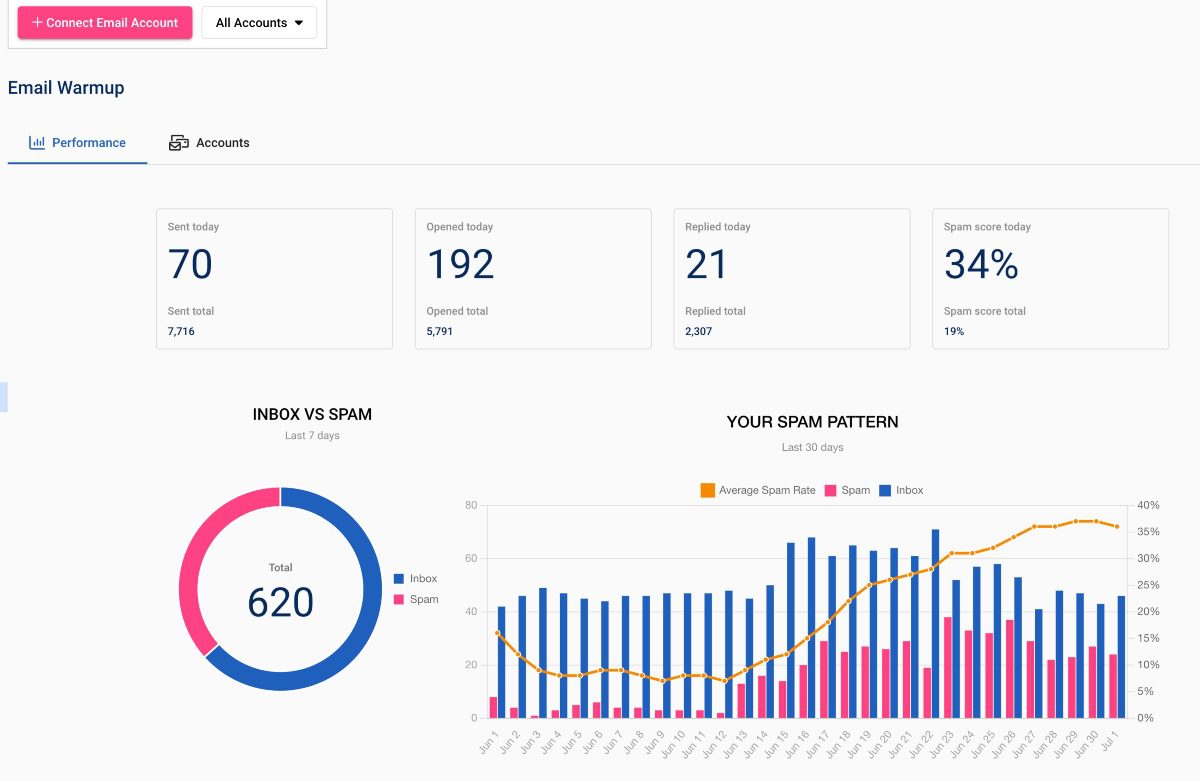
Mailshake, a popular cold email software, acquired the email warm-up tool ‘’Warm Up Your Email’’ in 2024 to ensure its customers' emails hit the inbox, not the spam folder.
The team at Warm Up Your Email manually interacts with your emails by opening them, replying, and pulling them out of spam. This interaction helps signal ESPs that you’re a trusted sender.
All you have to do is connect your email account and set your daily send volume while they handle the rest. You’ll get insights on how many of your emails land in spam and track your progress with a 10-day spam pattern report that shows your account’s improvement over time.
The downside? The process isn’t fully automated—it’s done manually by the Warm Up Your Email team. This can feel a bit counterproductive if you’re looking for full automation.
Additionally, their top plan caps the number of email accounts you can warm up at 8.
Not to mention, replies are sent as separate messages, not within the same thread, which might limit the natural conversation flow.
Pricing
Mailshake users can use Warm Up Your Email free of charge.
As for those who’d like to use it separately, the available plans are as follows:
| Sole Sender | $29/mo per user *1 email account / up to 50 interactions a day |
| Pro Sender | $49/mo per user *3 email accounts / up to 50 interactions a day |
| Agency Sender | $99/mo per user *8 emails accounts / up to 100 interactions a day |
9. MailReach - Best for real-time reputation tracking
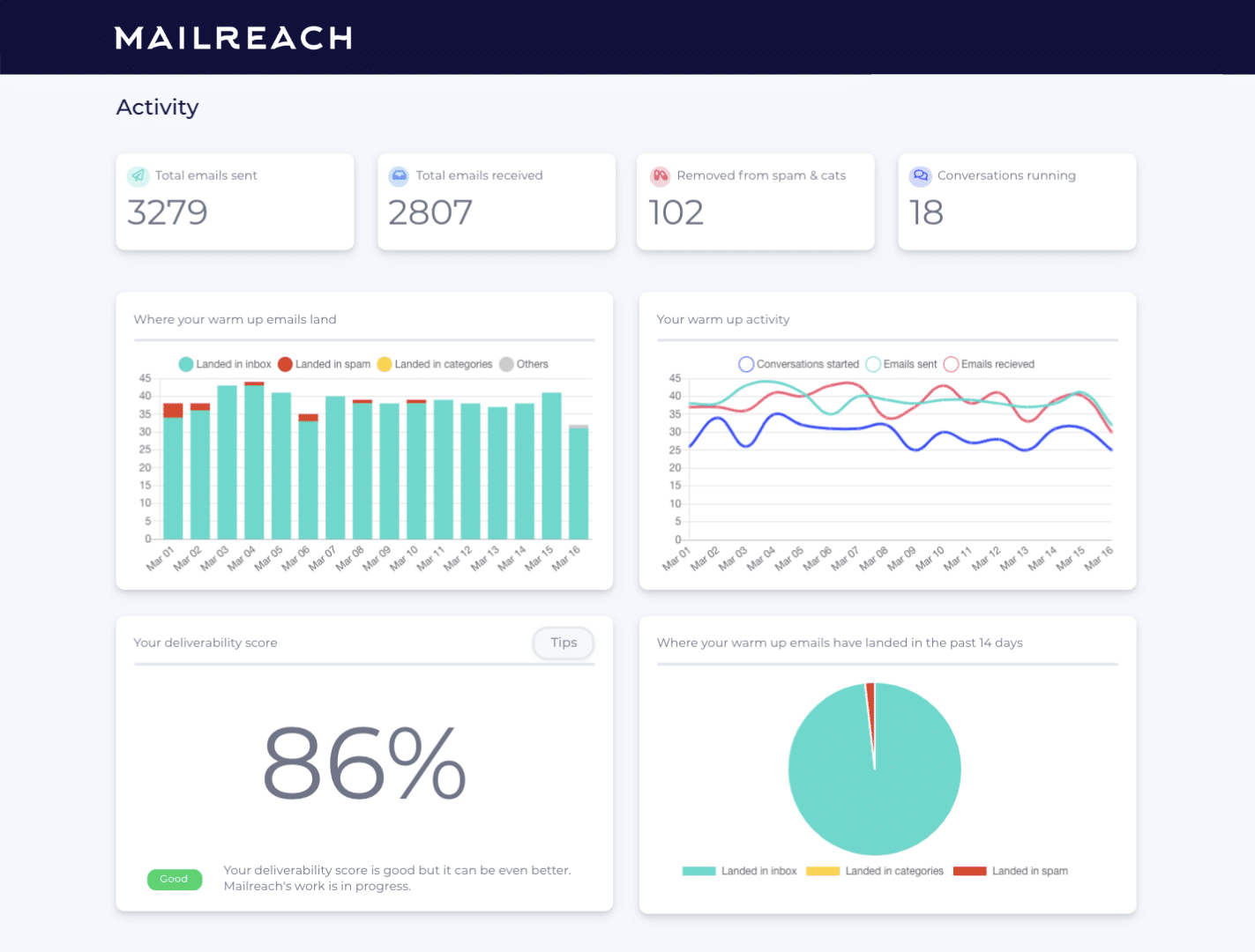
MailReach is an email warm-up tool designed to enhance your email deliverability, helping you hit more inboxes and land more deals.
It automatically repairs, improves, and maintains your sender reputation by facilitating genuine, positive interactions with a network of high-reputation accounts.
Its main feature is consistent spam checking, which allows you to track inbox placement and measure deliverability performance. You can run these tests manually or automate them based on your preferred frequency.
MailReach comes with a Smart AI warming algorithm that makes sure your account is properly warmed up before hitting full-scale outreach. At the same time, the Reputation Tracking Dashboard gives you real-time insights into your email performance, allowing you to fine-tune your campaigns as needed.
MailReach works with any email service provider that supports SMTP. However, the setup process can be tricky, especially when connecting emails for the first time.
Downsides-wise, since pricing is inbox-based and spam checker credits aren’t included in the base cost, you’ll need to account for those extras when budgeting.
Pricing
MailReach prices are based on the number of mailboxes you’re warming up, starting at $25 per mailbox.
Spam credits are sold separately, starting at $28 for 100, though you get 20 free credits to start you off.
10. Smartlead - Best for email provider matching
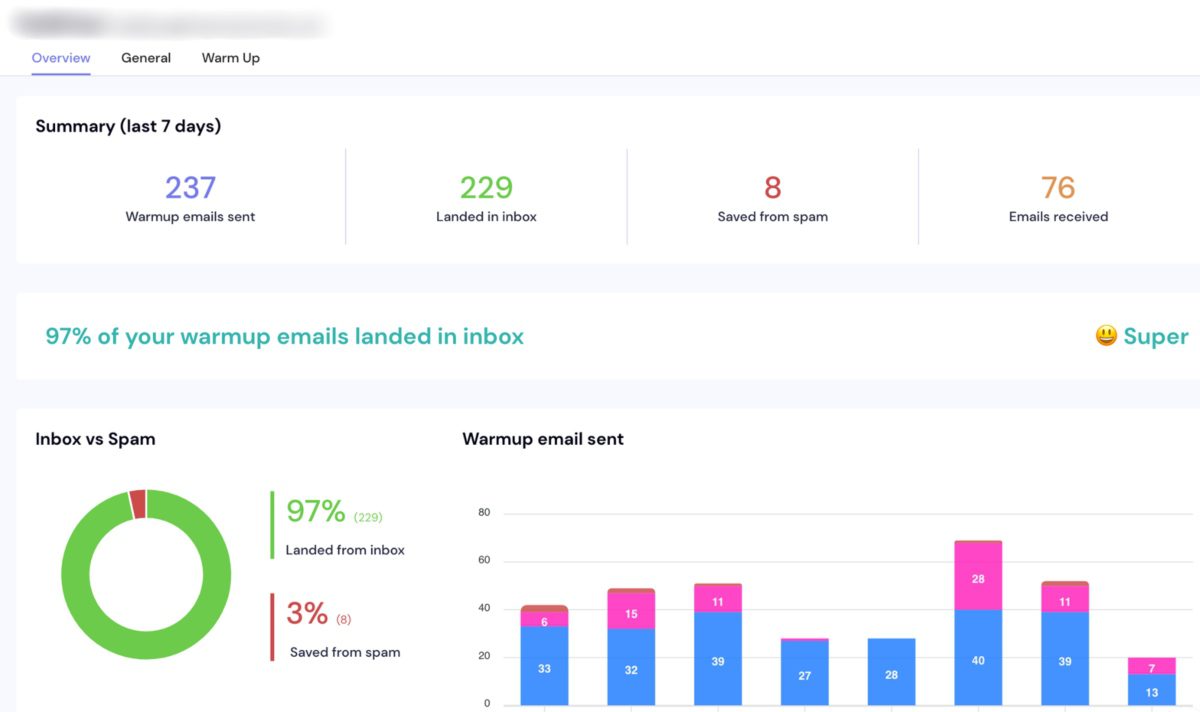
Smartlead is another tool that bundles email warm-up into its larger cold outreach infrastructure.
Its AI-powered warm-up emulates human conversations, allowing emails to appear natural and avoid automation detection. In addition to authentic AI conversations, the system delivers a gradual ramp-up for safe email sending.
One feature we really liked is how Smartlead automatically matches your email provider with that of your recipient. So, for instance, if you have both Gmail and Outlook accounts, and your recipient is using Gmail, Smartlead will use your Gmail account for optimal deliverability.
One downside, however, is the lack of customization—you can’t choose the topics or content for the warm-up messages. For this reason, and the fact that other warm-up tools offer more functionalities, you may be better off opting for one of the Smartlead alternatives.
Pricing
Much like Skylead and Instantly, Smartlead doesn’t have a sole email warm-up plan.
Instead, this functionality is included in their standard plans, which also give you access to email outreach.
| Basic | $39/mo per user *Unlimited email warm-up / Up to 2,000 active leads |
| Pro | $94/mo per user *Unlimited email warm-up / Up to 30,000 active leads |
| Custom | $174/mo per user *Unlimited email warm-up / Up to 12M active leads |
11. Mailflow by QuickMail - Best for blacklist tracking
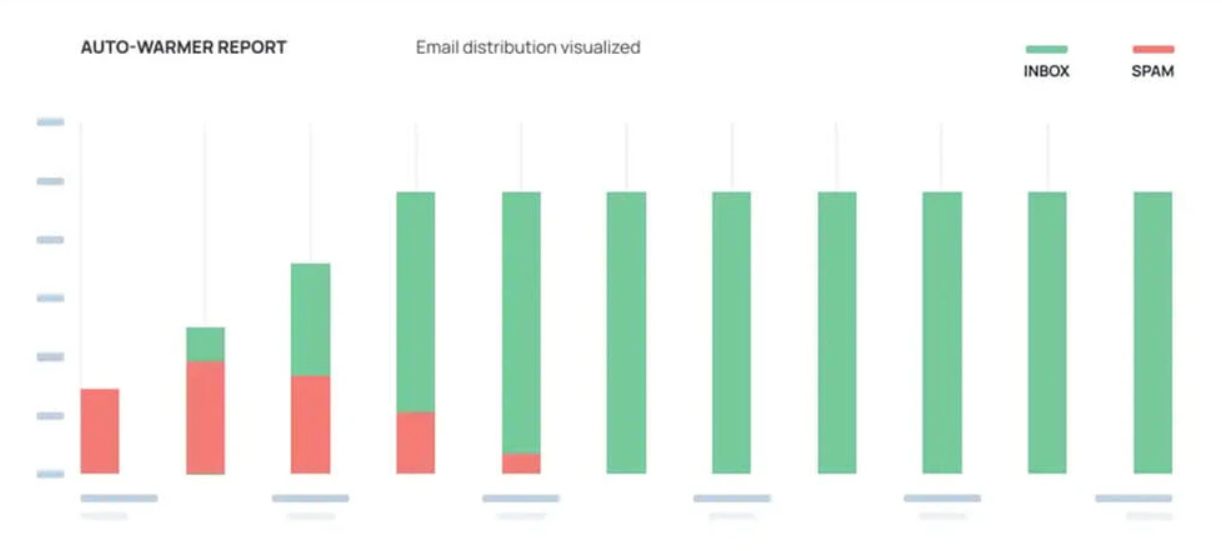
Mailflow is QuickMail's email warm-up tool, primarily aimed at its users. Nevertheless, it can also be used separately.
The tool is designed to improve your email deliverability with features like a real-time auto-warmer score for each inbox, SPF and DKIM monitoring, and blacklist tracking across nearly 100 lists. The latter makes it easy to act quickly if any blacklist flags your domain.
Unfortunately, its analytics are somewhat limited for our taste. In addition, the support team is only accessible via email, which can delay issue resolution.
Pricing
The tool is free for all QuickMail users.
Nevertheless, those who’d like to use it separately can expect to pay the following amounts:
| Free Pool *Up to 100 email accounts / maximum 5 warm-up emails a day | |
| Silver Pool | $49/mo per user *Up to 100 email accounts / maximum 30 warm-up emails a day |
| Gold Pool | $99/mo per user *Up to 100 email accounts / maximum 50 warm-up emails a day |
12. Allegrow - Best for integration with CRM and outreach platforms
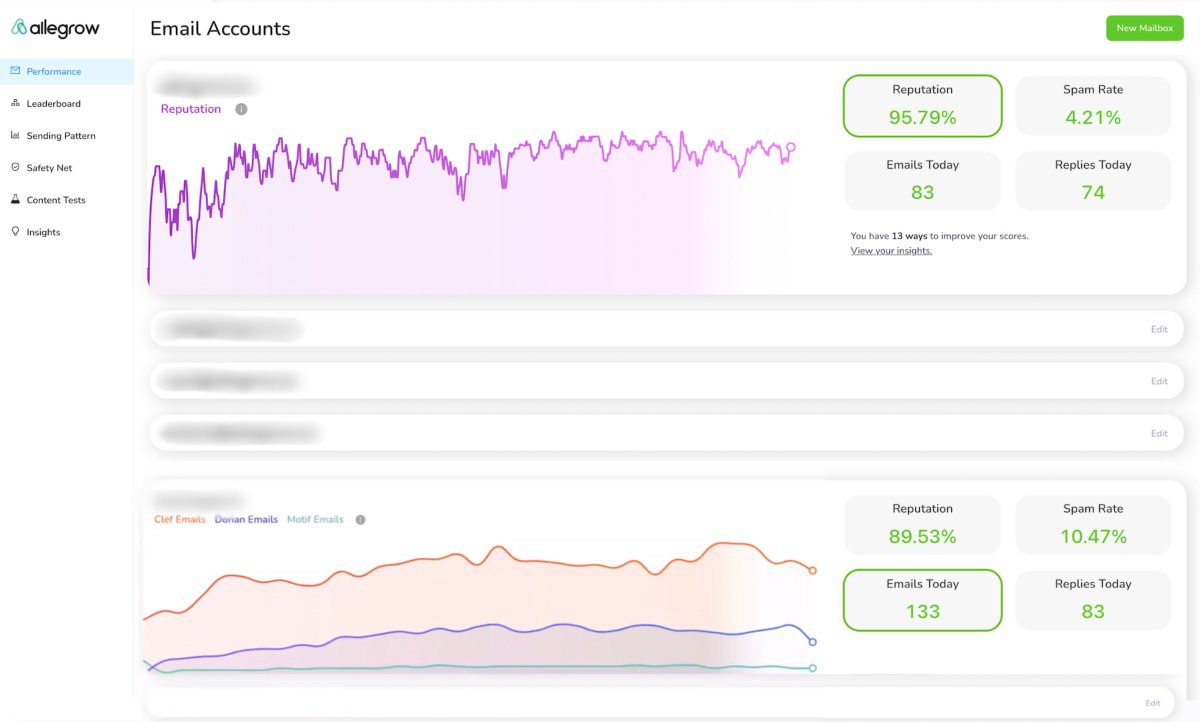
Allegrow is an email warm-up tool focused on delivering in-depth insights to help optimize your deliverability.
It offers unique features like Spam Rate Analysis, allowing you to see exactly how much of your email traffic ends up in spam. Also, there’s the Safety Net™, which automatically stops emails that could damage your sender's reputation.
With continuous DKIM, SPF, and DMARC testing, like InboxFlare in Skylead has, you’re also covered in authentication. At the same time, the Deliverability Leaderboard ranks users by spam rate to prevent one bad sender from affecting the whole team.
Another plus is that Allegrow natively integrates with popular CRM and sales outreach tools like Outreach.io and SalesLoft.
Not everything is ideal about Allegrow, though. The lack of pricing transparency is a con in our eyes. Moreover, the customization of warm-up messages is rather limited.
Pricing
Allegrow doesn’t share its pricing details publicly, so it’s likely they adjust prices based on the number of connected mailboxes.
However, sources suggest their plans start at $300 for 10 inboxes, which is, consequently, also the minimum you can connect.
How to choose an email warm-up tool
You’ve seen the top email warm-up tools—now let’s show you how to pick the best one for your workflow.
1. Look for features you need
Not all email warm-up tools are created equal, meaning they come with different features. With that in mind, start by identifying the ones that matter most to you.
Do you need automated sending and replying?
Customizable warm-up settings?
Or perhaps spam recovery features?
Either way, the tool you choose should have the functionality you need. Otherwise, what’s the point of paying for it?
2. Verify ESP compatibility
Before you invest in a tool, check that it’s compatible with your ESP. Some tools are specifically suited for Gmail, while others are optimized to work better with Outlook, Zoho, or more specialized ESPs. This step saves you from potential headaches down the line.
3. Assess ease-of-use and setup
Your ideal warm-up tool shouldn’t have a steep learning curve. Instead, it should be simple to set up and easy to navigate.
That said, look for intuitive dashboards, straightforward settings, and clear instructions. The less time you spend figuring out the tool, the sooner you’ll start seeing results.
4. Confirm support for multiple accounts and team usage
Running campaigns across multiple accounts and teams? You’ll want a tool that can handle it. So, make sure the tool supports multi-account use and includes team collaboration features. That way, you can streamline your efforts and keep everything organized.
5. Gauge the quality of customer support
Customer support can make or break your experience with any tool. After all, if things go sideways, you’ll need reliable help.
But how do you know the support quality if you haven’t used the tool yet? Check out reviews from real users. Their feedback usually reveals how responsive and helpful the support team is and whether they’re truly invested in resolving issues.
Ideally, the support team should be reachable 24/7 through multiple channels—live chat, email, phone, you name it.
6. Evaluate cost vs. feature ratio
Finally, consider whether the cost is appropriate for what you’re getting. Some tools are pricey but lack crucial features. Meanwhile, others offer everything you need at a reasonable rate. Compare pricing plans and weigh the cost against features to make sure you’re getting the best quality you can afford.
Frequently asked questions (FAQs)
Is email warmup necessary?
Yes, if you want your emails to reach inboxes instead of spam folders. Skipping this step can result in poor deliverability and a damaged reputation. Both of these can seriously hurt your outreach.
How can I warm up my email?
You have 2 options: manually or with an email warm-up tool.
To warm up manually, start by sending a small number of emails each day to trusted contacts—people who will open, reply, and engage with your messages. Gradually increase the volume over several weeks, allowing email providers time to recognize your account as trustworthy.
For a faster and more efficient approach, consider using an email warm-up tool. These tools automate the process by sending emails to a network of engaged users who interact with your messages, helping to quickly build your sender reputation and improve deliverability with minimal effort.
What is the best email warm-up tool?
One person's best may be another person's worst. So, the best email warm-up tool for you is the one that has the features you need, all while fitting within your budget.
Did Google ban email warmup?
Google didn’t ban email warm-up outright. However, they have restricted the use of third-party tools that access the Gmail API, which is often used for email warm-up. However, this move is about enforcing their policies against unauthorized API access, not banning the concept of warm-up itself.
That said, this doesn’t mean you can’t use email warm-up tools altogether. Many tools offer warm-up services that comply with Google’s policies by avoiding direct API access or by using methods that align with Gmail’s guidelines. So, if you’re using Gmail, just make sure you choose a tool that follows these regulations to avoid any issues.
Email warm-up tools: Final comparison
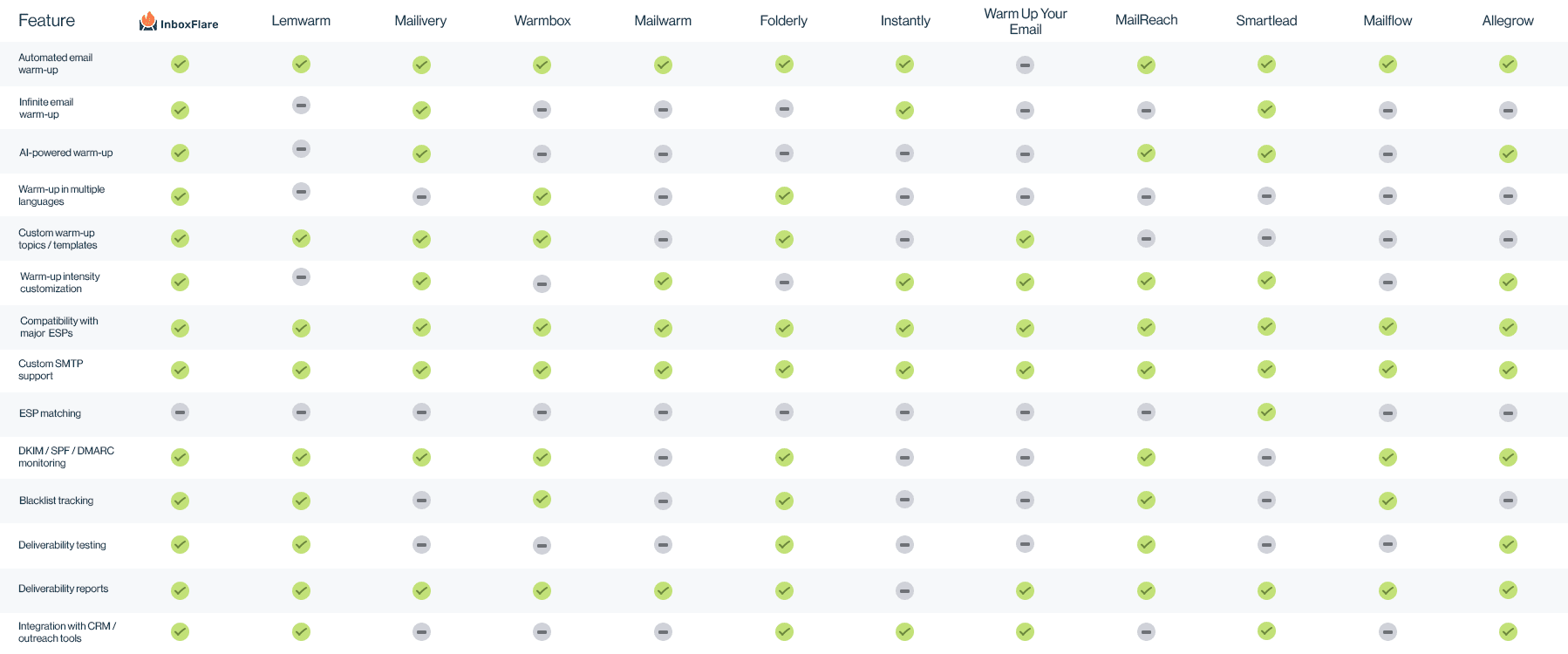
Your search for effective email warm-up tools ends here!
By now, you should understand just why you should warm up your emails.
And sure, there are plenty of email warm-up tools out there. But here’s the bottom line: your emails deserve to be seen. So, why mess around testing each tool when there’s already one that does it all—Skylead?
Skylead is a one-stop-shop tool that can help you warm up an infinite number of emails, discover and verify your leads' emails, and automate your LinkedIn and email outreach—all at a single price!
Sounds too good to be true?
Take it for a spin with our 7-day free trial to see the results yourself and start getting your emails exactly where they belong: in front of your audience!
Blank email interface. Insertion point flickers on your document. You can feel it staring back, almost judging you for not knowing what to write anymore for your cold email outreach. You tried everything - it’s not working, and you don’t understand what you are doing wrong.
Once again, without any inspiration, you scribble what your company does, offer a product, and mass blast it.
You wait. A couple of days later, history repeats itself. There is no response.
You think to yourself ’’This is too hard’’, or worse ’’This is not working for me’’.
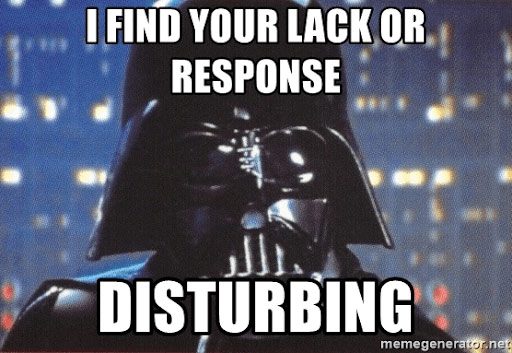
As Darth Vader, you start breathing heavily. Take off the mask and get wind of the list of cold email mistakes you're probably making, what impact they have on your email metrics, and how to fix them to improve email campaign performance.
Do not worry. These mistakes happen to everybody.
The most important cold email outreach metrics
Before we dive deep into these email mistakes, let’s recap the metrics you need to track that will tell you a lot about your overall campaign performance.
Understanding and tracking the email metrics is crucial when deciding if your outreach campaign was victorious. It’s like putting a billboard up in the city and not knowing how many people saw it or bought your product afterward. Thanks to technology, now you can.
To be more precise, to measure email performance, you need to knowhow many emails were bounced, opened, responded to, and how many people converted via cold email outreach. Once you have that mastered, you can start creating engaging cold email campaigns.
#1 Cold email metric: Bounce rate
Bounce Rate in email outreach is the total percentage of email messages that have not been delivered successfully. This can happen if for example an email address is invalid or there is a technical issue with the email provider.
How to calculate email bounce rate
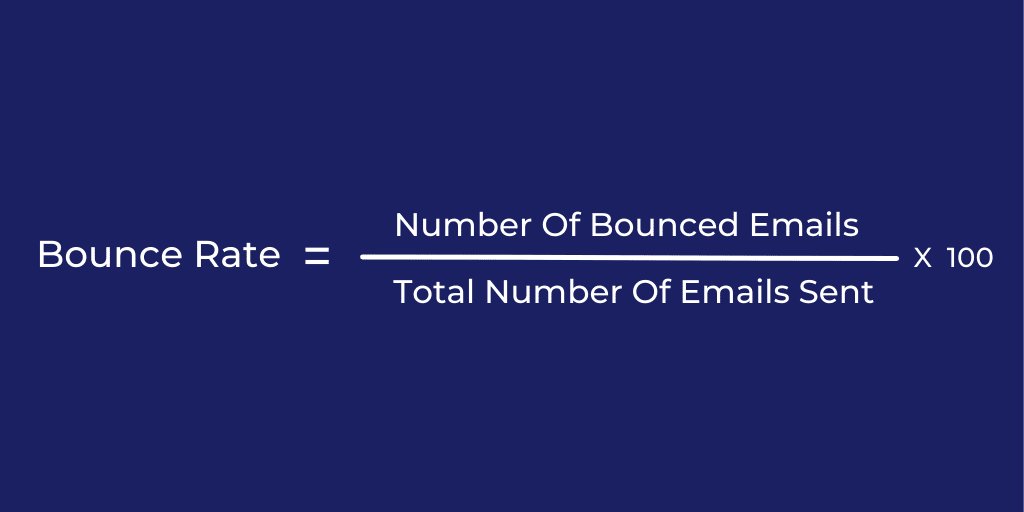
Example:
Let’s say that during your email campaign you sent 1000 email messages. Out of those, 98 weren’t successfully delivered. The calculation would go like this:
Bounce Rate = 98 / 1000 x 100 = 9.8%
#2 Cold email metric: Open rate
Email open rate is the percentage used as an indicator of email campaign health. The higher it is, the better.
This metric doesn’t tell you a lot about the email convertibility as a whole. However, it can indicate why it wasn’t opened, whether or not your subject line, or preview text (first several words of your email body) are appealing or can imply broken email deliverability.
How to calculate email open rate

Example:
Taking the numbers from the previous example, say, you have 1000 sent out, 98 out of those bounced and 565 were opened. The calculation will go like this:
Open rate = 565 / ( 1000 - 98 ) x 100 = 62.63%
#3 Cold email metric: Response rate
It’s nice to have a high Open rate, but it is even better to have a high Response rate, as well. As per its name, this metric indicates the number of individual emails in the cold campaign that leads responded to. This metric shows the quality of your email’s content. Ultimately, a good response rate means that you’ve managed to get the lead’s attention.
How to calculate email response rate
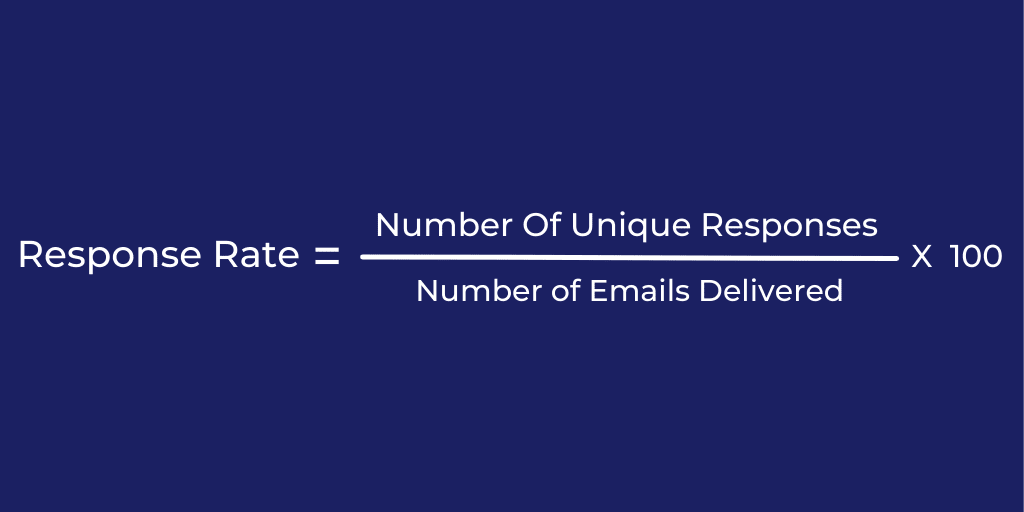
Example:
Continuing the example thread. Now you have 902 unique emails that have been delivered. Out of those, only 133 leads responded. The calculation goes like this:
Response rate = 133 / 902 x 100 = 14.75%
#4 Cold email metric: Email conversion rate
Conversion is an activity when a lead completes a desired goal, such as signing up for Demo or starting the Subscription. That said, conversion rate for email outreach is the percentage of prospects who took the desired action from your email campaign.
To find out more about conversions, their types, and other KPIs, check out 5 Must-Know KPI Metrics to Grow Your B2B Business [Bonus Metrics Included].
Needless to say, the conversion rate is the ultimate metric to figure out if an email campaign was successful.
How to calculate email conversion rate
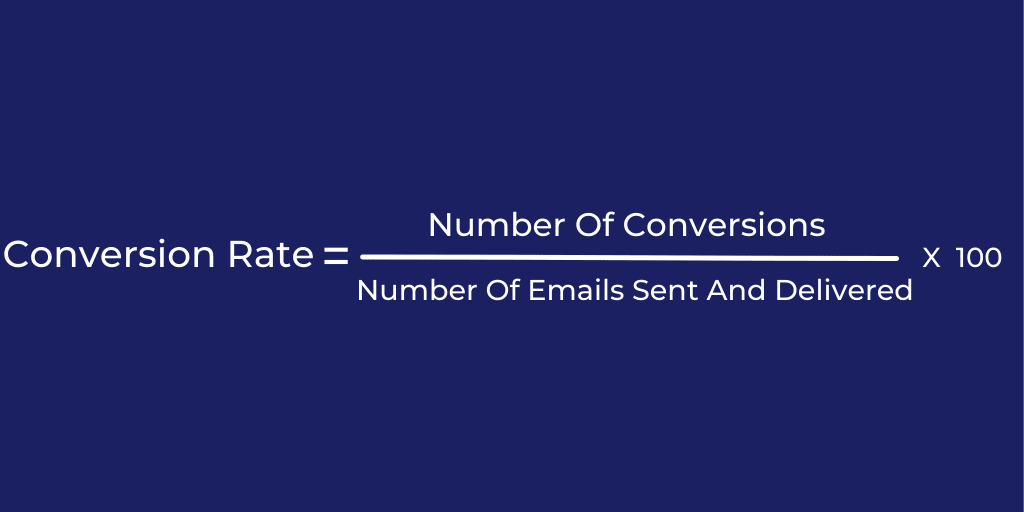
Example:
Out of 902 successfully delivered emails, you have 36 conversions in total. Calculation is the following:
Conversion Rate = 36 / 902 x 100 = 3.99%
Now let’s see what email mistakes you are making that negatively impact these metrics and how to correct them.
Cold email outreach mistakes to say goodbye to
Successful email outreach is a lot tougher than ever these days. With so many emails cramping up the leads inboxes, it is hard to remember and know what best works for your targeted prospects, let alone see the mistakes that slither in without you even noticing.
That’s why we created this ultimate guide to the most common email mistakes, how they affect the metrics, and how to fix them. First, let's break the email mistakes down into the following four categories to make it easier. There are Email Mistakes:
- Affecting Deliverability
- Regarding Content
- Related To Attitude Towards the Prospect
- Affecting Sales Process
I Email mistakes affecting deliverability
1. Acquiring poor quality leads
Let’s address the elephant in the room: many came across a situation where you are weighing options whether you should go for a cheaper alternative or not when buying prospects’ data. Unfortunately, the cheaper option almost always leads to devastating results in the end.
Starting, the leads’ contact information you get from unverified vendors might be completely untargeted for your outreach. You can get every mistake right on this list, but if your ICP is not targeted, the entire email outreach will fail.
Or, maybe the prospect’s name is incorrect, and you might address them wrongly which will definitely affect the response rate and you will lose this lead. Forever.
But there is a worse case scenario above all: if emails are invalid or non-existent, they can crumble your email outreach efforts because it increases the bounce rate and risks getting your domain blacklisted.
Think of it as the butterfly effect: the bigger the bounce rate is, the more it damages your domain health and increases the danger of getting your emails in the spam folder or domain blacklisted. It also decreases your open rate, response rate, and conversion rate in the long run.
What to do?
Buy the data from well-established and verified data vendors or gather the right information as first-party data yourself.
Another solution is to find a reliable partner for data research or introduce your sales team with a sales engagement tool for outreach that has email discovery and verification features.
2. Adding a big number of links or sending the broken ones
Everyone wishes to tell the prospect as many things as possible about our product or service. We want to show them the blogs, ask for a meeting, attach a whitepaper file and add alternative comparison pages for them to see. While this confuses the prospect regarding CTA (which we will mention below), it also overcrowds the email itself, making email providers raise their robot heads as bloodhounds. Too many links or files in your email will trigger a warning to the email provider and increase the possibility for your emails to twirl down to the Spam folder.
Furthermore, if you send a broken link to prospects, they will think of you as an unprofessional or worse spammer, and it will decrease the response and conversion rates, as they will lose interest in you.
What to do?
Try to keep the number of links to a minimum as you can (preferably without any links), and of course, check the links before sending.
Additional tip: If in your signatures you have linked icons, check every one of them. As those links count as well, and sometimes they get broken, it’s better to be safe than sorry.
3. Sending too many messages per day
We all wish to send as many emails as possible for a short period. But this is a big mistake, especially if your email address is new. Sending too many emails per day can result in your messages ending up in the Spam folder. This can be one of the causes of your open rate dropping.
What to do?
Slowly warm up your email address manually by sending a low number of emails, and then gradually increase the volume over some time. Or, use email warm-up tools to do it automatically. The warm-up of a new email address or domain can last from 30 to 90 days.
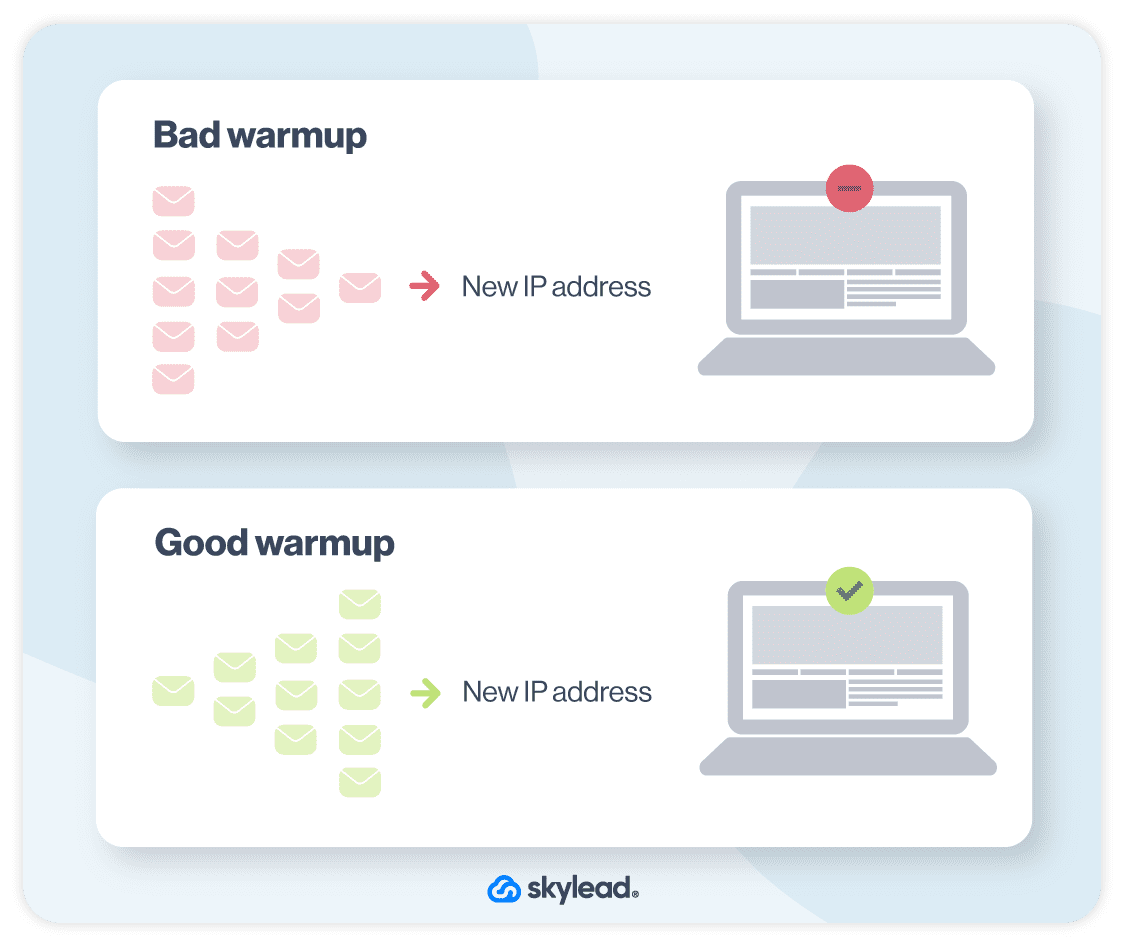
II Email mistakes regarding content
4. Being too casual or too formal
Balance is everything. Sales representatives sometimes go overboard trying to get their prospects to laugh, which only ends up being too cringey. We do not say GIFs or jokes are bad, we even use them in outreach, and thread them to the context of the message. So know what thy boundaries are.
Then on the other side of the scale, we have an overly formal approach. The truth is that everyone wishes to be respected, so a formal approach is good, but if you go overboard, you will sound like a robot.
What to do?
Find the balance between the two scales. You can even send personalized GIFs or Images to show creativity and genuine interest, but keep it tasteful.
When it comes to an overly formal approach, you can loosen up a bit.
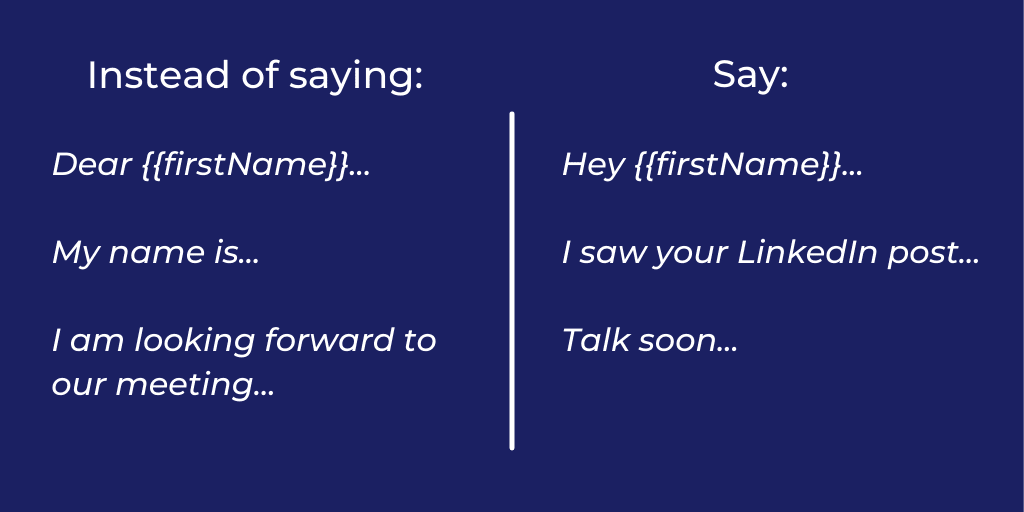
5. Subject lines mistakes
Coming up with the subject line cannot be an easy feat. It has to be attractive, short, explain everything but still leave the prospect interested in clicking on it. As challenging as it is, there are still some mistakes people make when it comes to these:
- Spammy or clickbait subject lines - Big no. It will only enrage your prospects.
- Subject lines not specific enough for the market – This can cause lower open rates as the prospects will not relate to the email at all.
- Subject lines in caps lock - It’s good to be excited, but you don’t need to shout at your leads to get the attention.
What to do?
These mistakes influence every important email metric starting open rate, so make sure to avoid them. Think about how you would attract the leads’ attention and bind the subject line as a whole with the email body. Even better, try to make the subject line as a prequel to your Preview text of the email and make it a united lead magnet.
6. Message copy not relevant to the market
As mentioned for the subject line, you need to keep a close eye on your email content's relevance to the market, as well. Writing an email not relevant to the industry can result in a lower response rate and conversion rate.
What to do?
Go full private detecting on this one. Research the industry, find the pain points. Go even further - find prospects' companies and information about them. Show them you understand the industry problems and what solution you offer instead.
7. Self-centered messages to prospects
Writing messages that are more focused on you instead of your prospects’ companies can come across as being too aggressive or assertive, resulting in lower response rates.
What to do?
Instead, be aggressive in knowing your lead: Showcase the research you did on them, ask for the call to know more about their pain points and see how your product or service can aid them further.
People resonate with what’s in it for them. Talk about them, gain their interest through email.
Example:
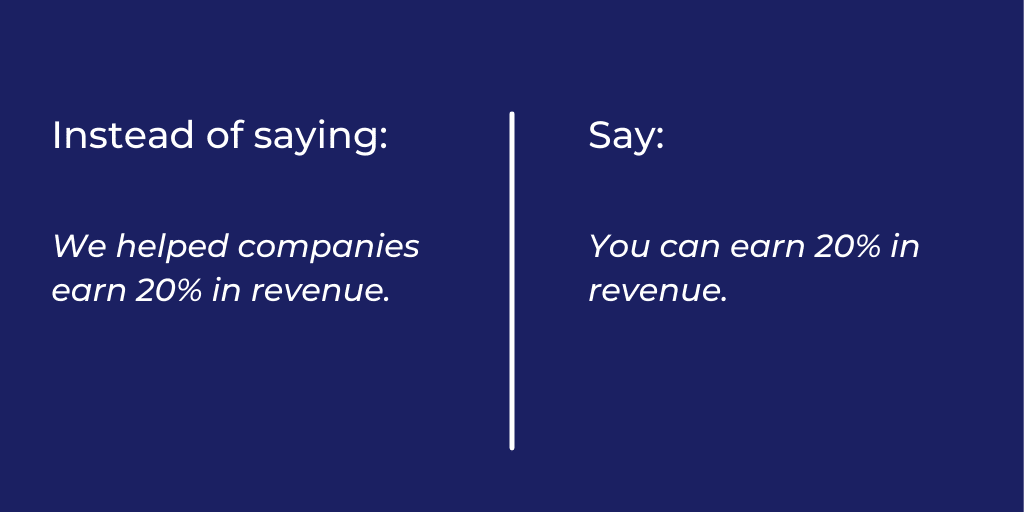
8. Adding too much CTAs or not at all
As mentioned above, if you wish to show the prospect the blog posts, ask for a meeting, add alternative comparison pages for them to see, and top it off with a YouTube video - Stop.
All these are a type of call to action, and piling them in one email will only confuse the prospects regarding CTA.
On the other hand, if you do not use CTA at all, you will lose the purpose of your cold outreach, so the prospects won’t have action in their mind to fulfill.
What to do?
The goals of outreach campaigns are different for every purpose. Define one short CTA, and stay away from the unclear ones.
For more information on CTA in sales emails, check out our Detailed Guide On Crafting The Powerful Call To Action.
9. Not enough value
Often, our value proposition is not deep enough, doesn’t hit the bullseye, and is too generic. This directly affects the response rate, and you will lose the prospect as you weren’t compelling enough.
What to do?
Once again, put on your detective glasses and go into deep search of a particular prospect’s main pain points. You need to know and understand them.
If you can explain their situation better than they can, they will automatically assume you have the solution and gain interest.
Example:
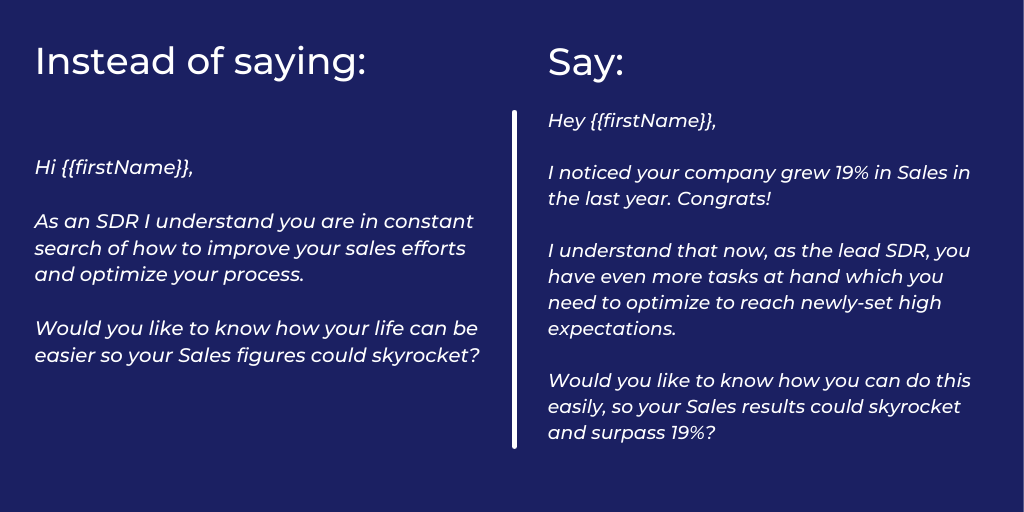
10. Unnecessary text length
If your cold email message is too long and has numerous paragraphs, take a step back.
Let's say you are reaching out to CEOs or other higher-up positions. They usually have a lot on their plate, so you probably know the one virtue they lack is time. Please make sure to not waste it.
What to do?
If you can draw the line through any piece of your text without losing the value, remove it.
Let's say you have sentences such as:
- I know you are busy but...
- I’m following up...
- I’d love to give you a demo…
- Do you perhaps know when would be the best time...
You won't lose the value if you cut them off. So instead, tell them something short, sweet, and essential about their business in particular, straight to the point:
- I see that your company struggles with VALUE...
- Would Wednesday at 10 AM work for you...
III Email mistakes related to attitude towards the prospect
11. Questioning the prospects integrity and authority
Now we have a mistake example, which is little farther down the cold email outreach sequence. Let’s say you have a correspondence with the lead from medium or large company who you are not sure if they are a decision maker or not.
Asking a straightforward question ’’Are you the right person?’’ or responding ’’I guess you are just not the right person to reach out to’’ after they do not reply is a big no-no.
Simply do not ask a straightforward question if someone is a decision-maker. If not a decision-maker, they would feel invalidated.
Or maybe they indeed are, but your outreach was just not that compelling enough to respond to, or they might think ’’If I'm not, would you treat me with the same respect?’’ Either way, this is how you will decrease your conversion rate.
What to do?
If you really wish to know if someone is the right person to reach out to, then you can say something like this:
When you bought this {{Product}} in the past, who was involved in the process?
12. Being authoritative over or submissive under the prospect
There are three ego states in the body: child, adult, and parent ego state. If you command someone to do something, you talk to someone from the parent's ego state, and they will automatically go to their child's ego state.
An example would be ’’Let me know the time that works for you’’.
How would you feel if you got this sales email?
Would you want to rebel against that sentence? Your prospect would want to rebel too.
Another example would be if you start your email with just a prospect's name, it will trigger a child's ego state, and they will think they are in serious trouble. You would want to increase the chance of somebody responding, so when cold outreaching, your goal should be to trigger ONLY their adult ego state.
What to do?
So what to avoid in communication exactly?
- Commanding to prospects to do something (Child ego state trigger)
- Putting accountability on them for not responding (Child ego state trigger)
- Invalidate their objections (Child ego state trigger)
- Sentences like:
- Just checking in...
- I know you are busy but…
- Would you have the time… (Parent ego state trigger)
Overall avoid triggering their Parent or Child ego state. Instead, trigger an adult ego state.
For example, instead of saying:
Would you have the time…
You can offer an up-front contract. For example, write the exact time and date of the meeting and ask for consent. Additionally, provide an agenda for your call.
13. Judging or making the prospects feel bad
Even though you think you will never do this to your prospects, this type of mistake is one of the most common ones.
The first example is being harsh regarding the leads' choice to use similar products. Even though you are not saying anything bad about the leads themselves, you are indirectly insulting the decision they made. This easily translates to insulting them.
What to do?
Instead of judging the prospect for using a competitor and bragging why your product is better, say something like this:
Oh, you are using an XY competitor? That’s great! So you are familiar with the type of product itself. What differs our product from them is…
Also, do not allow your words to make your prospects feel bad. Put the onus on you, not on your prospect.
Example:

IV Email mistakes affecting sales process
14. Not setting up follow up messages sequences
Not having your follow-up game is the next in line of common lead generation mistakes (both for lead generation on LinkedIn and off). If the prospect doesn’t reply, do not give up.
Follow-up emails always get a better response rate than the first email. In this study, there is an illustration of difference as follow-ups got 18% response rate higher than the first email, 13% to the fourth, and 27% to the sixth email *.
What to do?
Set up follow-up emailing sequences for the prospects who did not respond. Even if they do not respond to these follow-ups, insert them for other purpose sequences. Never give up, and never give in.
15. Not tracking email campaigns’ performance
As we mentioned in the beginning, tracking is everything when it comes to your sales effort, especially if we talk about cold outreach.
If you do not know what you are tracking, how would you know if the channel is effective?
What to do?
So be sure to set and track the following:
- Bounce Rate
- Open Rate
- Response Rate
- Conversion Rate
On the other hand you can use a LinkedIn automation and cold email software such as Skylead to track it for you. Analyze the chosen tool thoroughly and start tracking your performance.
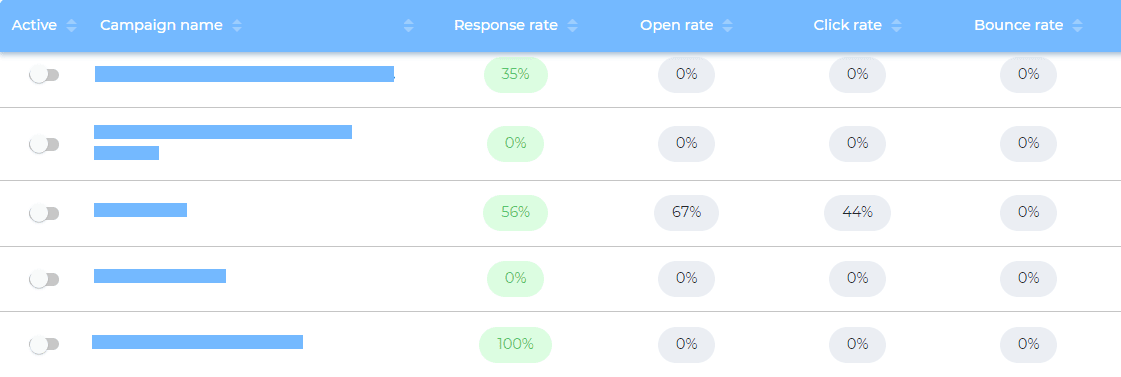
Honorable mentions
We cannot finish this blog, without mentioning a couple of short email mistakes which are essential to correct.
16. Poor Grammar - you have so many grammar checkers and tools available on the internet nowadays to remove sloppiness in communication.
17. Using initials - signing your email message using your initials such as J.K. can come across as unprofessional. Use your full name and surname in your signature.
18. Not personalizing the email - Nowadays, in the cold outreach, you need to step up your personalization game, especially if you did the prospecting on LinkedIn first. To learn all about outreach personalization check out Cold Outreach: Increase The Level of Personalization [+Templates]
Summary
Cold email outreach is still a powerful tool for lead generation and conversion if done right. Take time to study all of the mistakes mentioned above, let them be your guide, and double-check.
Here are all the email outreach mistakes to serve you as a checklist:
1. Acquiring Poor Quality Leads
2. Adding A Big Number Of Links Or Sending The Broken Ones
3. Sending Too Many Messages Per Day
4. Being Too Casual Or Too Formal
5. Subject Lines Mistakes
6. Message Copy Not Relevant To The Market
7. Self-Centered Messages To Prospects
8. Adding Too Much CTAs Or Not At All
9. Not Enough Value
10. Unnecessary Text Length
11. Questioning The Prospects Integrity and Authority
12. Being Authoritative Over Or Submissive Under The Prospect
13. Judging Or Making The Prospects Feel Bad
14. Not Setting Up Follow Up Messages Sequences
15. Not tracking email campaigns’ performance
16. Poor Grammar
17. Using initials
18. Not personalizing the email
Now get too cold email writing - You’ve got this. Godspeed!
Wish to use email and LinkedIn in your outreach and successfully track their performance? See Skylead in action - Start your 7-day Free Trial.
Email Marketing has maintained popularity over the years.
It is an efficient way to get new leads, nurture relationships and raise awareness about your business.
With the right strategies, you can gain new customers, as well as develop trust with current clients.
That is, it can become a trusted way to boost sales and grow your pipeline in no time or simply sustain good results long term.
Some businesses have not yet developed tactics for productive Email Marketing. That’s why it is resulting in modest effects or no effects at all.
Disappointed by sparse returns, some have given up on the idea. Most likely they miseed out on perks provided by a good Cold Emailing strategy.
But were they right?

Why is Email Marketing important?
It’s true that in order to grow your business through Email Marketing you need to know a few tips and tricks. However, keep in mind that learning them will be very rewarding.
Did you know that, according to several studies, campaigns that were implemented through email generated significantly more profit compared to ones run through Social Media Networks?
Fact check: A whopping 99% of consumers check their emails every single day. Therefore, the cold mailing is one of the most reliable ways for businesses to develop relationships and boost sales.
Investing a single dollar in Email Marketing brings a return on investment of 40 USD.
Check how much better it rates compared to other forms of Digital Marketing in the chart below.

Knowing just how profitable Email Marketing is, makes learning the right methods definitely worthwhile. Additionally, with the right tool, you are guided through the experience with the utmost care provided by our Customer Support Team and cutting-edge technology.
With Skylead, you can send up to 100 emails per day. However, we always recommend starting off with a lower number, so that your emails don’t finish in a Spam folder.
Contacting leads through email is for sure the most sustainable way to reach more people over time.
So, how do you start Email Marketing or improve existing strategies?
We’ve prepared 10 tips and tricks to help you boost your sales via email and help you achieve the best results.
1. Understanding your audience
When starting out with Email Marketing, it’s crucial for you to understand your target audience.

Who are they?
What do they like?
How can they benefit from your services or products?
After you answer these questions, it will be much easier for you to figure out the perfect way to reach out to them. You will be able to find the tone your audience will enjoy, one that will truly captivate their attention.
But, wait, that seems like a lot of work!
Don’t worry. With Skylead’s state-of-the-art tool, the process of targeting is eased to the extent that building your perfect customer pool will take less than 5 minutes.
With Sales Navigator filters, you can do the prospecting on LinkedIn, and find leads according to their location, employment, connection degree (1st, 2nd, or 3rd degree), position, used keywords, groups, and much more. In other words, you can narrow down your ideal audience to decision-makers who will benefit from your services big time.
And this is the part of LinkedIn Lead Generation done right.
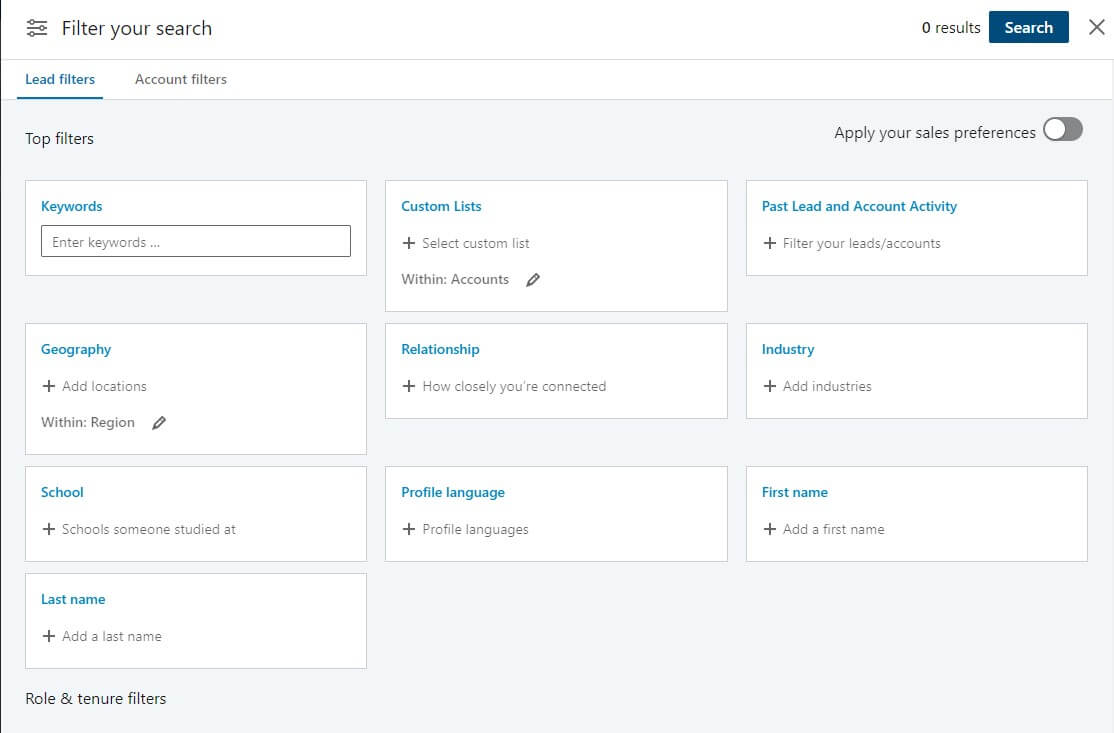
Also, have in mind that writing a copy that will be relevant to your target market is now pretty simplified. It will for sure result in a higher response rate compared to generalized Email Strategies.
2. Expanding your mailing list
Many people make the mistake of thinking that putting a form on their website and hoping that visitors sign up will be enough to expand their Mailing list.
Unfortunately, it doesn’t really work that way.
In order to really build an extensive network of potential clients, you’ll either need some time and creativity to get more leads, or you can rely on our innovative Email Discovery feature. It will help you access the email addresses of the most important people related to your industry in just a few clicks.
Skylead’s Email Discovery feature brings the possibility of collecting personal email addresses, incorporated in a lead’s profile, or even a business email.

The alternative is creating lead magnets that will help you receive email addresses. Give something for free in exchange for contact details. It can be a free ebook, a case study, or a product sample – really anything potential customers might find valuable enough to hand out their email address.
Ture, this can take quite some time and resources. But, if you’ve already managed to acquire a rich source of contacts, make sure you make the best use of it.
3. Nurture relationships
In order to reap the most benefits of your EM strategy, it will be necessary to build a relationship with people and companies from your contact list.
You can achieve this by sending out regular emails and follow-ups. These need to keep the interest of respective clients, which is crucial for boosting your sales efforts.
It’s not easy to manually send emails to each contact on your list. We understand that you’re already busy building your business and don’t have enough time to allocate to that part.
That’s why we in Skylead developed a tool that can help you save up to 7 hours a day. Skylead is there to send multiple emails, customize automated messages, and schedule your follow-ups. Furthermore, it is providing a well-organized dashboard and inbox, ensuring you never miss a single message.
4. Segment your mailing list
Not every offer will be equally interesting to your entire list. That’s why segmenting the list is a very important step. It can help you keep your efforts engaging by only sending relevant information.
The sublime labeling option in Skylead’s inbox allows you to best segment your recipient list using easy-to-use sticky notes, helping you provide a tailored experience for your subscribers.
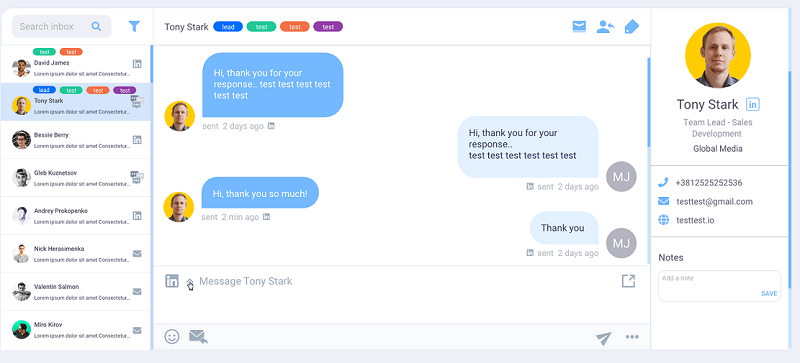
Segmenting your lead list will help you speak directly to your consumer. You will be able to provide them with engaging content that will keep you out of the spam box.
5. Mix up your campaigns by using different outreach channels
You’re used to having Skylead on your side with LinkedIn steps such as Connection Invites, Messages, View & Follow Options, and LinkedIn InMails, but we don’t want you to stop there.
No, we want you to use the full potential of our Sales Engagement tool! It is here for your business to shine.
Email, as a powerful form of Direct Marketing, is now integrated into our platform, allowing you to set up a campaign with LinkedIn located steps but now also send your messages via email.
And the best thing is – you can mix emails with every other step there is.
6. Test, test, test
Skylead helps you run multiple campaigns where you can comfortably run A/B tests to figure out the most efficient approach for you.
Try it by pitching two campaigns A and B, to slightly different target groups, with slightly different messages and see how they will react. Track the outcome and find what works best for your business.
Also, there are target groups that are naturally more OPEN for InMails. Make sure to not forget that feature.
By combining all the features and options Skylead offers you, you’ll be more than able to run a good test.
7. Ask for feedback
The best way to keep prospects from your Mailing list engaged is to ask them what they’d want.
Sounds too simple?
Well, people love to be included and appreciate the effort to accommodate their needs. Therefore, asking them about things they’d like to see in your newsletter or suggestions regarding your product/service will not only provide you with helpful information, it will also make your contacts feel appreciated.
That way, your contacts will be interested and invested, making it more likely that they’ll reply or hopefully make a sale. As soon as they see you care about their opinion, they’ll be twice as likely to engage with you.
8. Warm up your cold emailing
What better way to keep your audience engaged than to find a way to speak directly to them?
Just because you automated sending, it doesn’t mean you should write them as if you’re speaking to a large group, disregarding their personalities and needs.
Skylead is bringing you a great way of designing your messages so they seem as if every single email was aimed directly at that particular person.
Wondering how to do that? We got you covered!
Use tags in a message and include details such as first and last name, occupation, years of experience, education, and other relevant data to add warmth to your cold emailing.
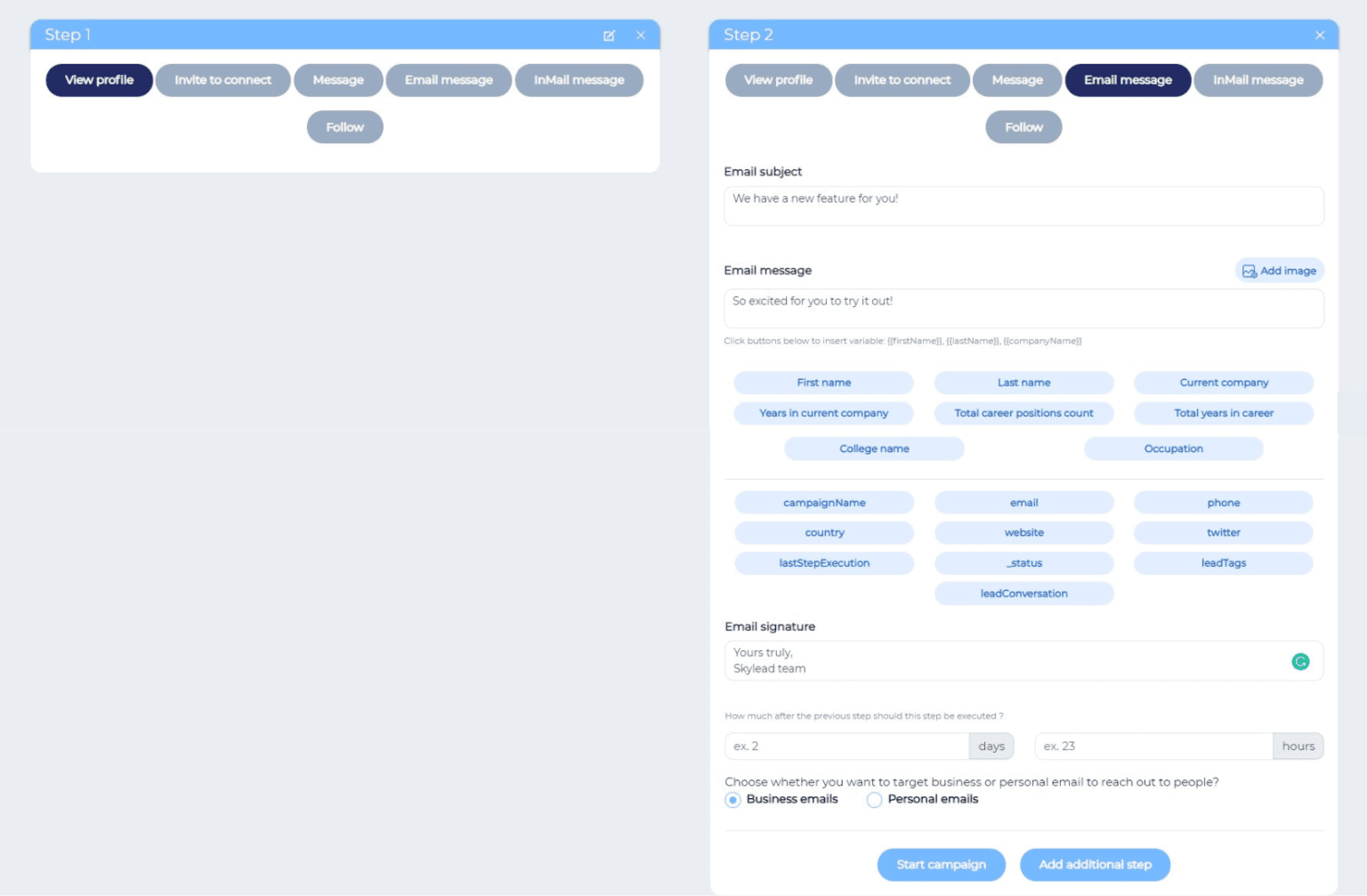
Use behavioral data to craft emails that resonate with your contacts and potential clients.
9. Create a highly enjoyable customer experience
It’s worth repeating that impersonal ads, promotions, and sales pitches in emails make a lousy customer experience.
How can you do better, you ask?
Put yourself in the shoes of the receiver. Would you be annoyed or entertained by the content?
Our technology will instantly pause the automation if someone replies. This will give you space to decide whether it’s okay to continue the sequence. If so, you can get a lead back to the campaign.

That’s how we nurture sequences based on leads’ actions and prevent them from sending unwanted emails if they state they are not interested.
10. Add an extra something
Show your subscribers you care about them by including an extra token of affection.
Try Skylead’s awesome Image Personalization feature that will add some color to plain text, making them even more appealing to potential customers.
Choose between our funny, or even corpo visuals if you like, and include details such as the recipient’s name, occupation, workplace and more, to make a cool addition to brightening their day.
You can choose from a variety of templates we’ve prepared for you or simply import some of your images, to really stand out from the crowd and multiply your response rate.
One way to grab the attention of your audience is to also congratulate them on holidays for New Year by including your logo and recipient’s name to a cool, personalized card – what better way to nurture your relationship with clients than send them a cool e-card and wish them good luck.

Read more about our new Email Automation & Image Personalization features here.
And, of course, if any questions arise you can always count on us to chat it through.
Thank you for reading and stay tuned for more blogs.

